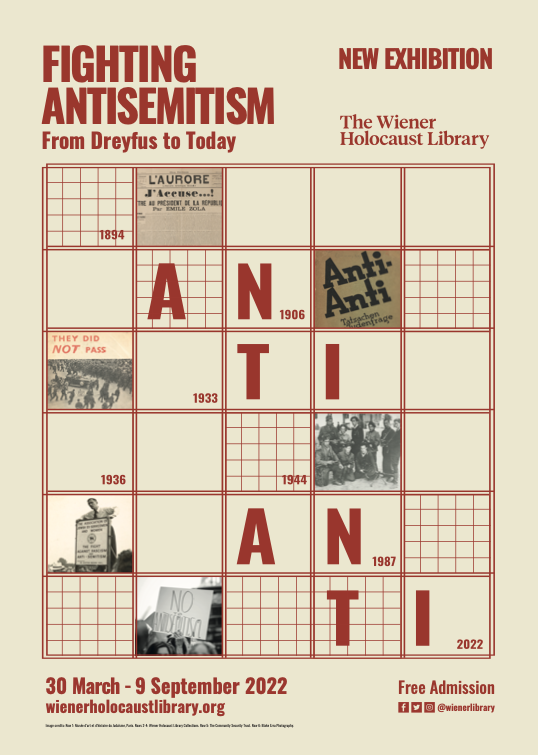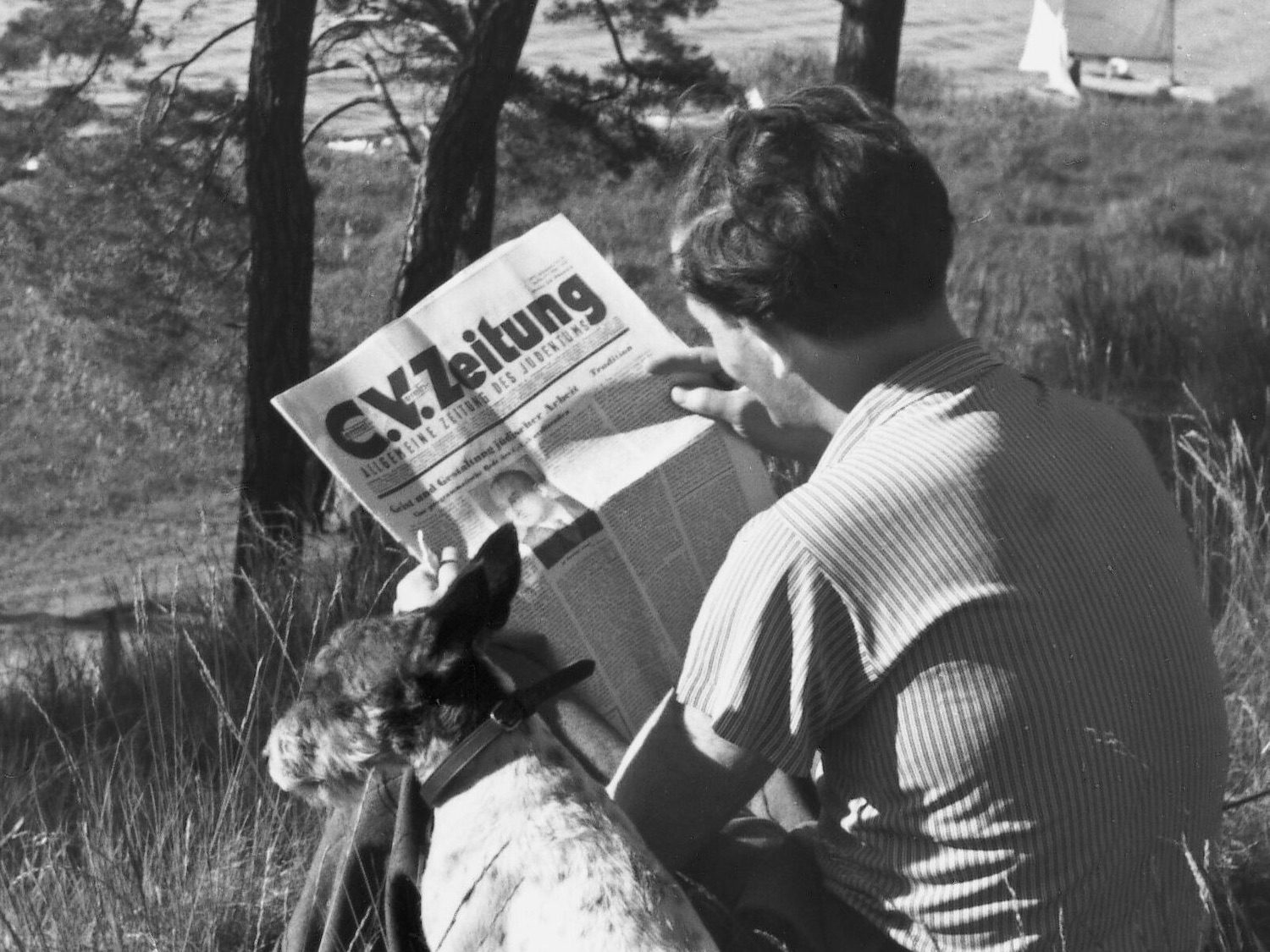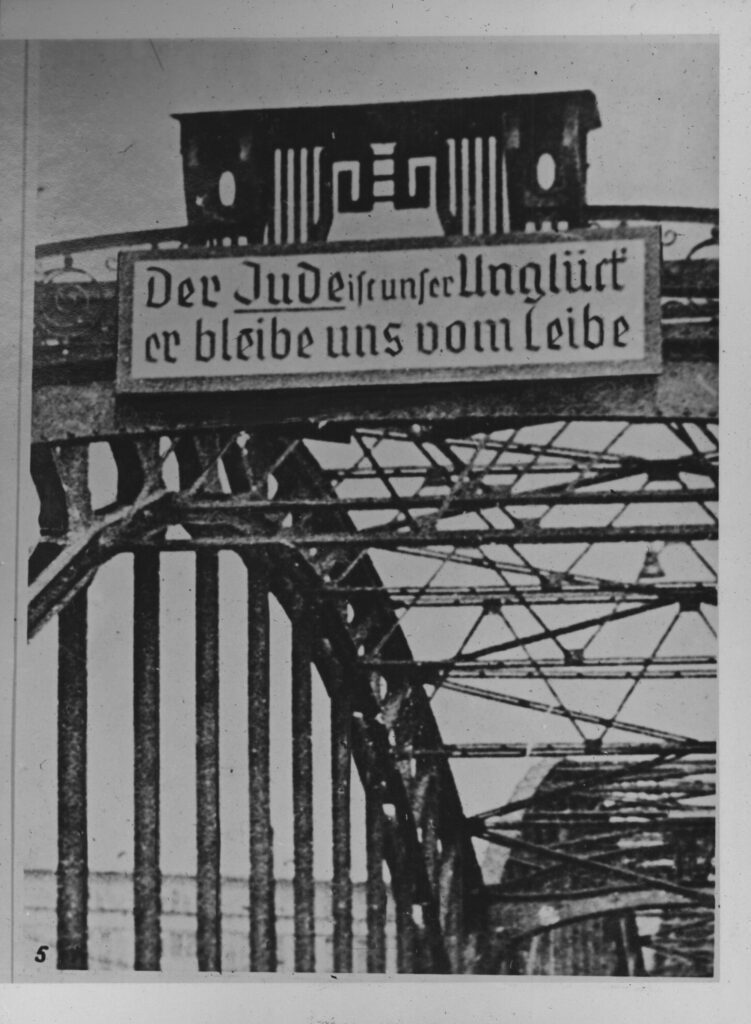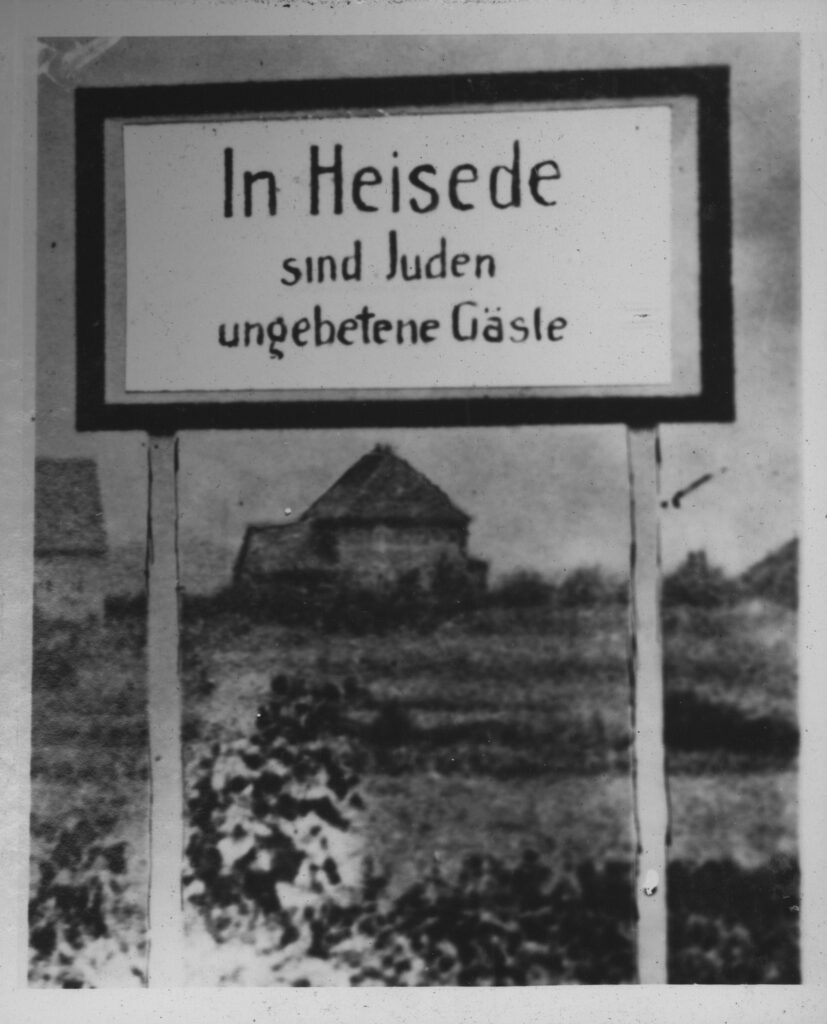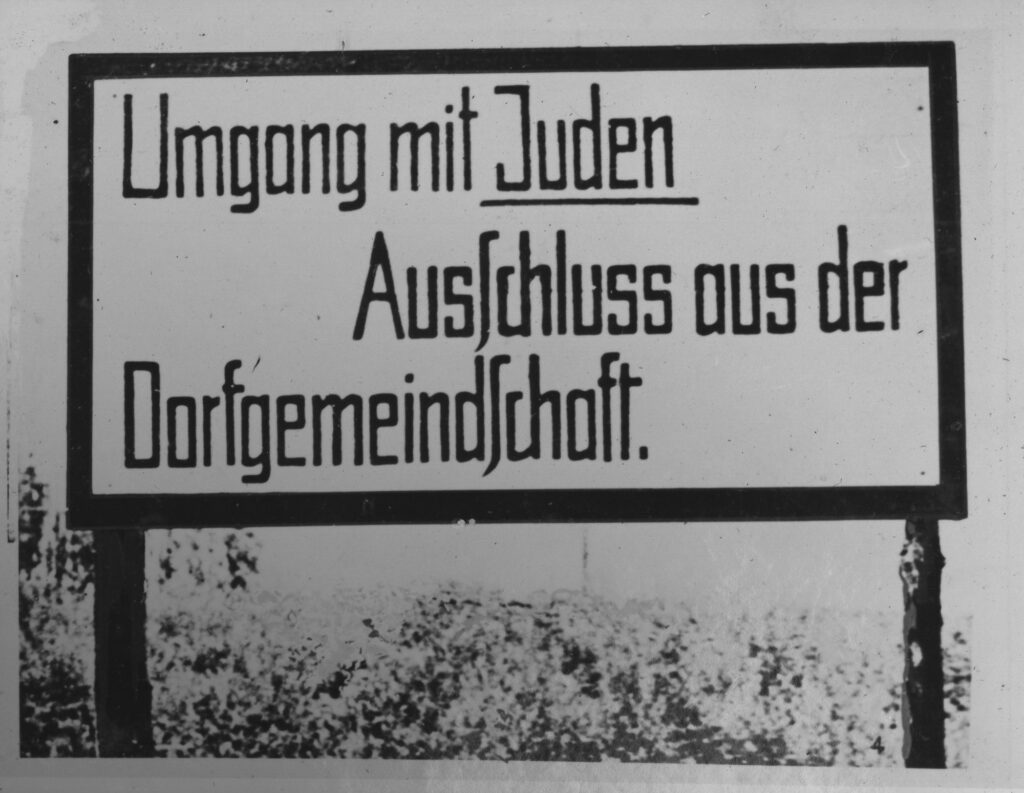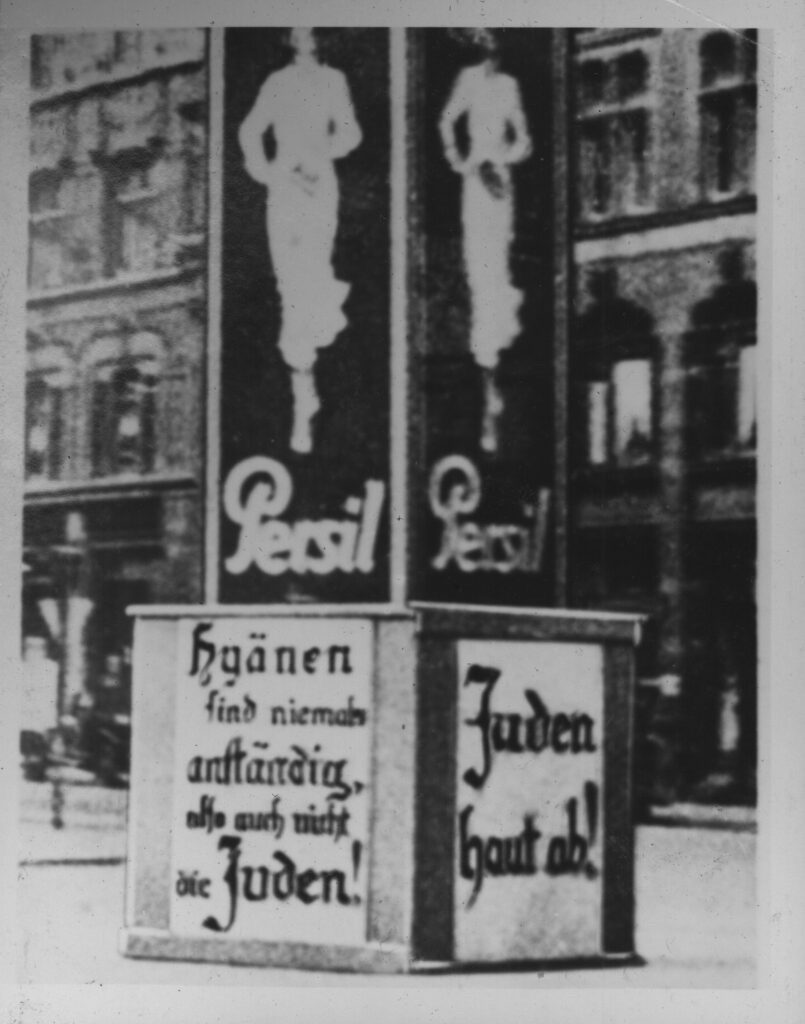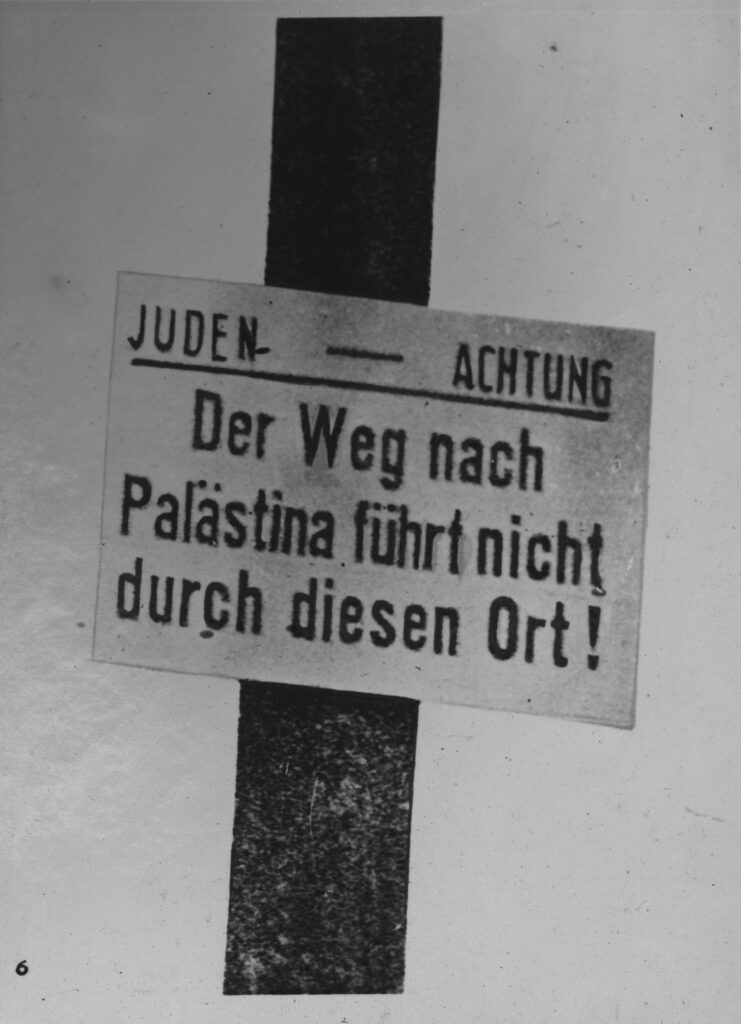Fighting Antisemitism from Dreyfus
to Today
The arrest, trial and imprisonment of Jewish French Army officer Alfred Dreyfus on false charges of espionage became a sensation in the 1890s in France and across Europe, galvanising both antisemites and their opponents.
This exhibition draws upon the archives of The Wiener Holocaust Library to explore some of the individuals, organisations and campaigns that have fought back against antisemitism in France, Britain and Germany since this critical moment.

Émile Zola, ‘J’Accuse…! Lettre au Président de la République’, (I Accuse! Letter to the President of the Republic), 13 January 1898, courtesy Musée d’art et d’histoire du Judaïsme, Paris
In Germany in the 1920s, Alfred Wiener challenged antisemitism. In 1933 in Amsterdam, he founded the Library’s predecessor organisation to monitor antisemitism and campaign against it.
In this pamphlet, Wiener analysed the activities, rhetoric and sources of funding of antisemitic groups in Germany after the First World War.
He warned that there was a danger that violence against Jews in Germany could escalate.
Alfred Wiener, Vor Pogromen (Before Pogroms), 1919, Wiener Holocaust Library Collections
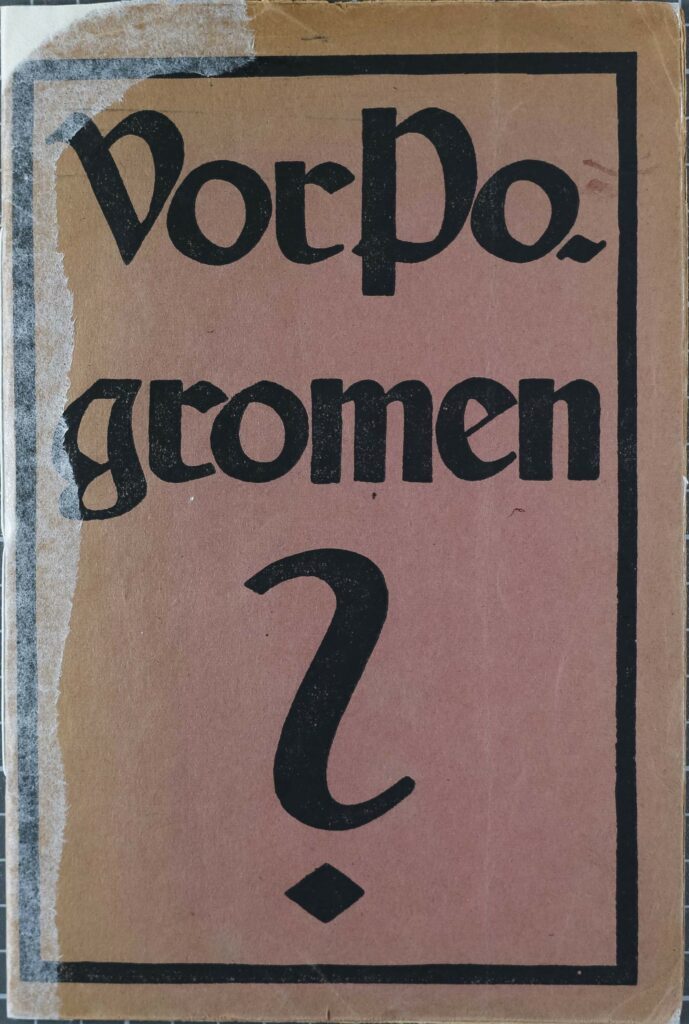
With the support of
The David Berg Foundation
With thanks to Dave Rich, Daniel Sonabend,
Dawn Waterman and the family of Mildred Levy

In Britain after the Second World War, the Association of Jewish Ex-Servicemen and Women held street meetings to challenge antisemitism and fascism on the streets.
Dates that Jews gained emancipation and equality under the law

Various editions of The Protocols of the Elders of Zion, collected at different times by the Library and its predecessor organisations as part of their fight against antisemitism, Wiener Holocaust Library Collections
The Protocols were a forgery produced in France in the 1890s by an anonymous author in the service of the Russian police. The document claimed that there was a Jewish conspiracy to take control of the world. The extent of editions of this publication within the Library’s collections show the persistence of the influence of this cynical piece of antisemitic propaganda.
In 1933–1935, the Library’s predecessor organisation, The Jewish Central Information Office (JCIO), provided information to support a legal action brought by the Swiss Jewish community, who sued the Swiss National Front for disseminating antisemitic propaganda. In the course of the trial, it was established that The Protocols of the Elders of Zion were a fake.
JEWS AND ANTISEMITISM
IN THE LATE 1800S
By the late nineteenth century, Jews in Western Europe had gained many of the social and political rights previously denied to them, such as the right to vote and stand for election. People of Jewish faith or background occupied positions as politicians, prime ministers, business leaders and academics. Prejudice remained, however, and antisemitic incidents and even violent attacks on Jews still occurred.
From the 1880s, as an extended economic recession blighted Europe, new ideas about antisemitism began to take hold, including the notion that Jews controlled finance and capitalism. Pseudoscientific concepts of ‘race’ cast Jews as a group with biologically inferior characteristics who threatened the genetic ‘health’ of supposedly ‘superior’ racial groups.

Sir Moses Montefiore by Henry Weigall, 1881, courtesy of the National Portrait Gallery
Sir Moses Montefiore (1784-1885) was a financier, Jewish community leader and philanthropist, and President of the Board of Deputies of Britain Jews 1835-1874. Montefiore travelled aboard repeatedly to intercede on behalf of Jews affected by antisemtism.
Portrait of Theodor Mommsen by Franz von Lenbach, 1897, courtesy DLA Marbach
Mommsen was one of the founders of the Verein zur Abwehr des Antisemitismus (Association for Defence against Antisemitism), founded in Berlin in 1890 to challenge rising antisemitism in the German Empire. The organisation was dissolved after the Nazi accession to power in 1933 .
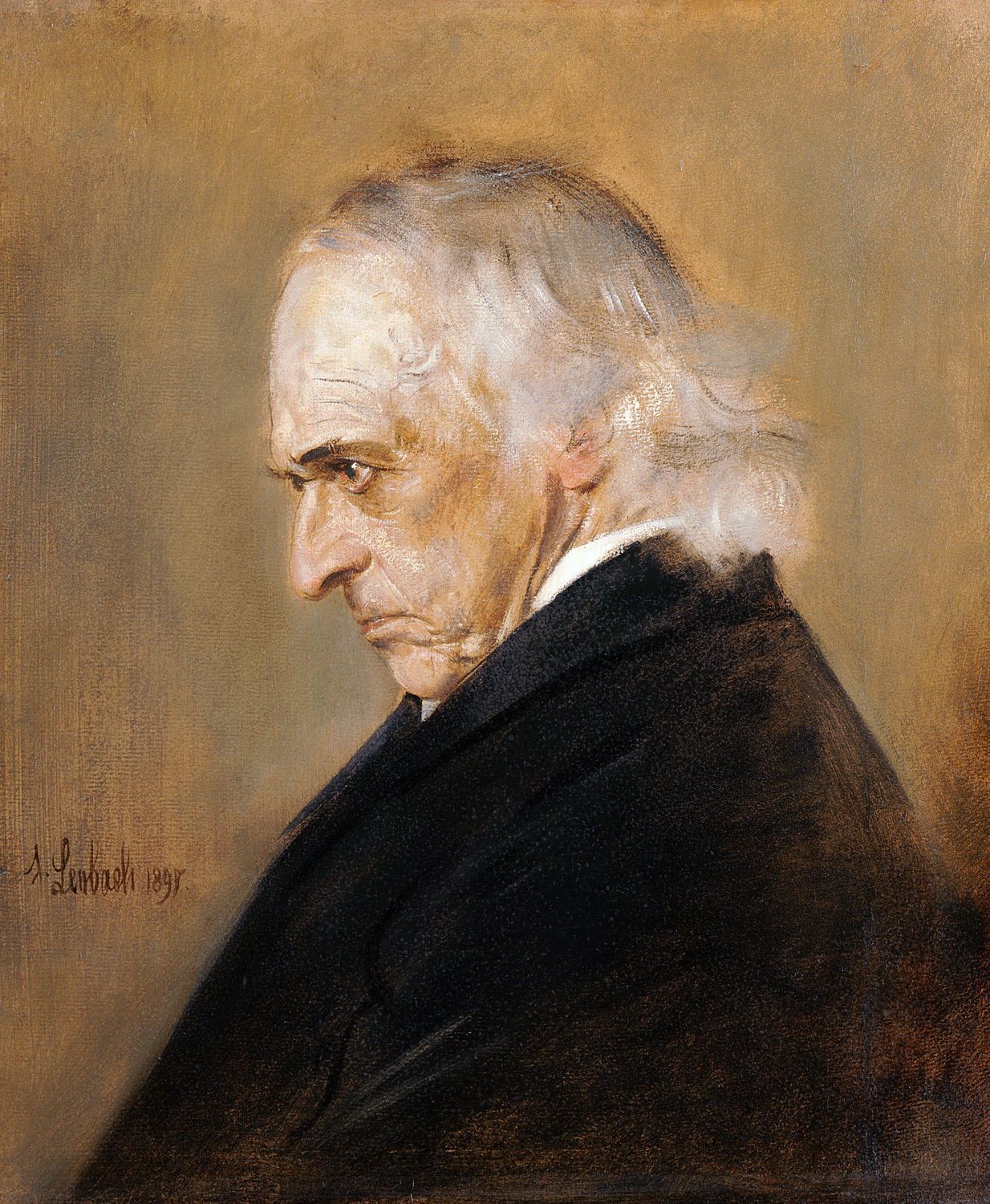

A Funeral for desecrated Torah scrolls following the Kishinev pogrom of 1903, public domain
From the 1870s, pogroms – orchestrated violent attacks – were perpetrated against Jewish communities in the Russian Empire. During the 1903 pogrom in Kishinev in Moldova, 49 Jews were murdered and hundreds of Jewish women raped. By the late nineteenth century, it was only in the Russian Empire that antisemitism was official state policy.
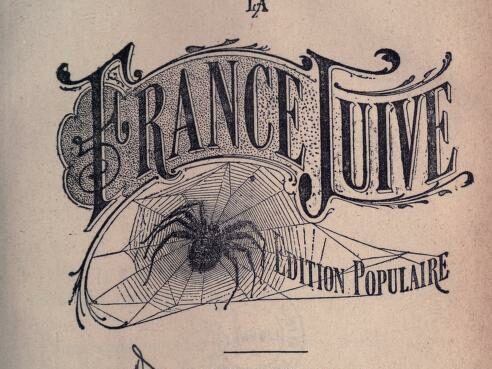
Eduard Drumont, La France Juive (Jewish France), Paris, 1886, Wiener Holocaust Library Collections
Drumont’s book promoted extreme antisemitic ideas. It represented Jews as the eternal enemy of non-Jews and of France. It was reprinted 114 times and sold 150,000 copies.
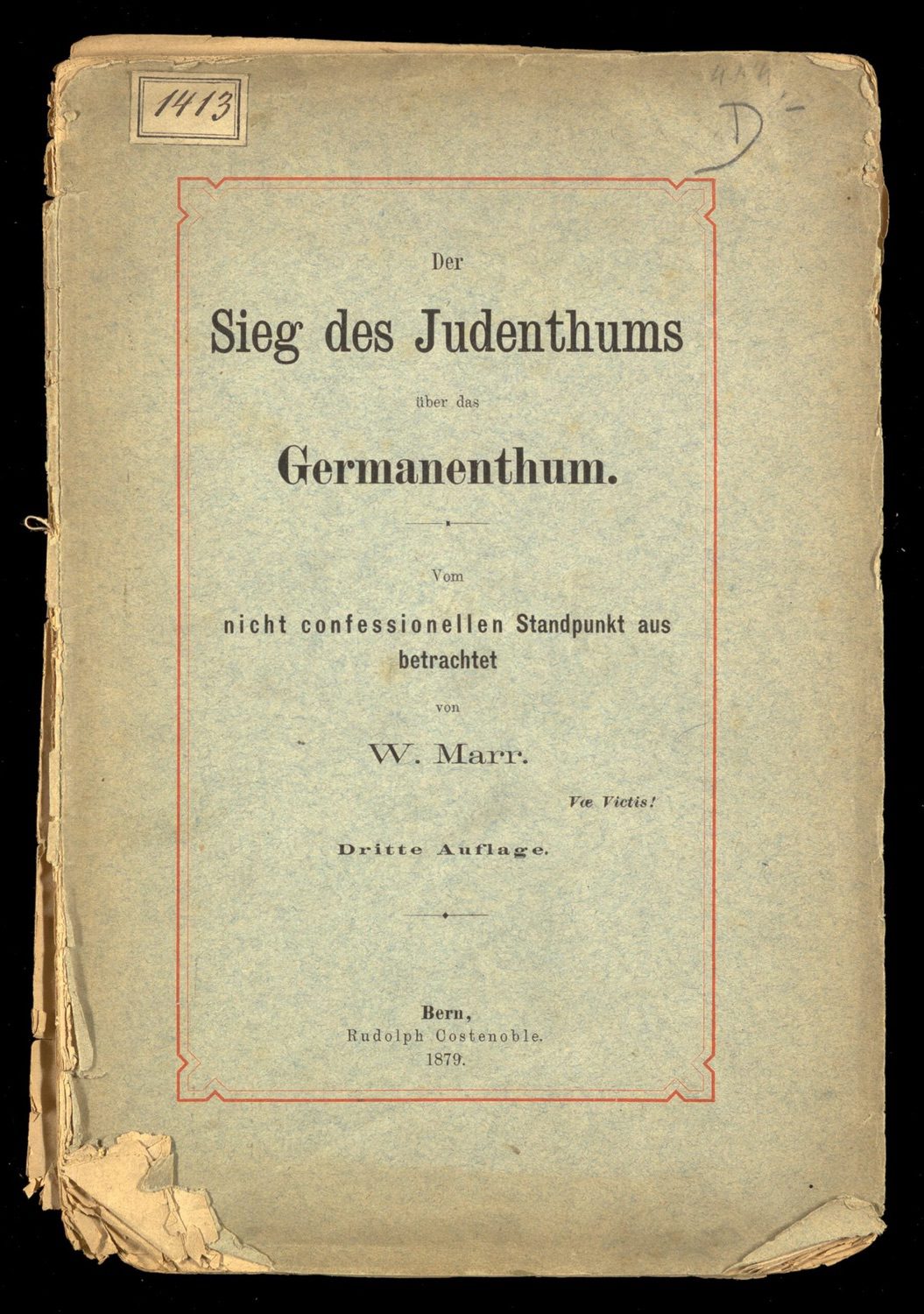
Wilhelm Marr, Der Sieg des Judenthums über das Germanenthum: vom nicht confessionellen Standpunkt aus betrachtet (The Victory of Judaism over Germanism: viewed from the non-confessional standpoint), Berne, 1879, Wiener Holocaust Library Collections
An edition of this antisemitic German work from its first year of publication, during which it was reprinted twelve times. Wilhelm Marr’s pamphlet promoted paranoid delusions about the supposed power of Jews in Germany. In the same year that it was published, Marr set up the Antisemiten Liga (Antisemitic League).
“Jew, usurer, trafficker:
for me these are synonymous”
Alphonse Toussenel, author of antisemitic work,
Les Juifs: Rois de L’Epoque (Jews: Kings of the Age), 1847
“The Jew remains a Jew,
a parasite race, enemy of work.”
Pierre-Joseph Proudhon (1809-1865),
the founding father of anarchism, 1860
Proudhon and Toussenel were among those who advanced the
antisemitic notion that Jews acted as a group to economically exploit others.

‘Le Veau d’Or’ (The Golden Calf): The worship of riches, Le Petit Journal, Paris, 21 December 1892, courtesy of Musée d’art et d’histoire du Judaïsme, Paris
In 1892, the Panama Canal Company collapsed, taking with it many French investors’ savings. Le Petit Journal blamed ‘Jewish financiers’ for the situation, reflecting the antisemitic idea that Jews involved in finance acted in concert to undermine the position of others. The cover illustration suggested that Jews worshipped a golden idol of money.
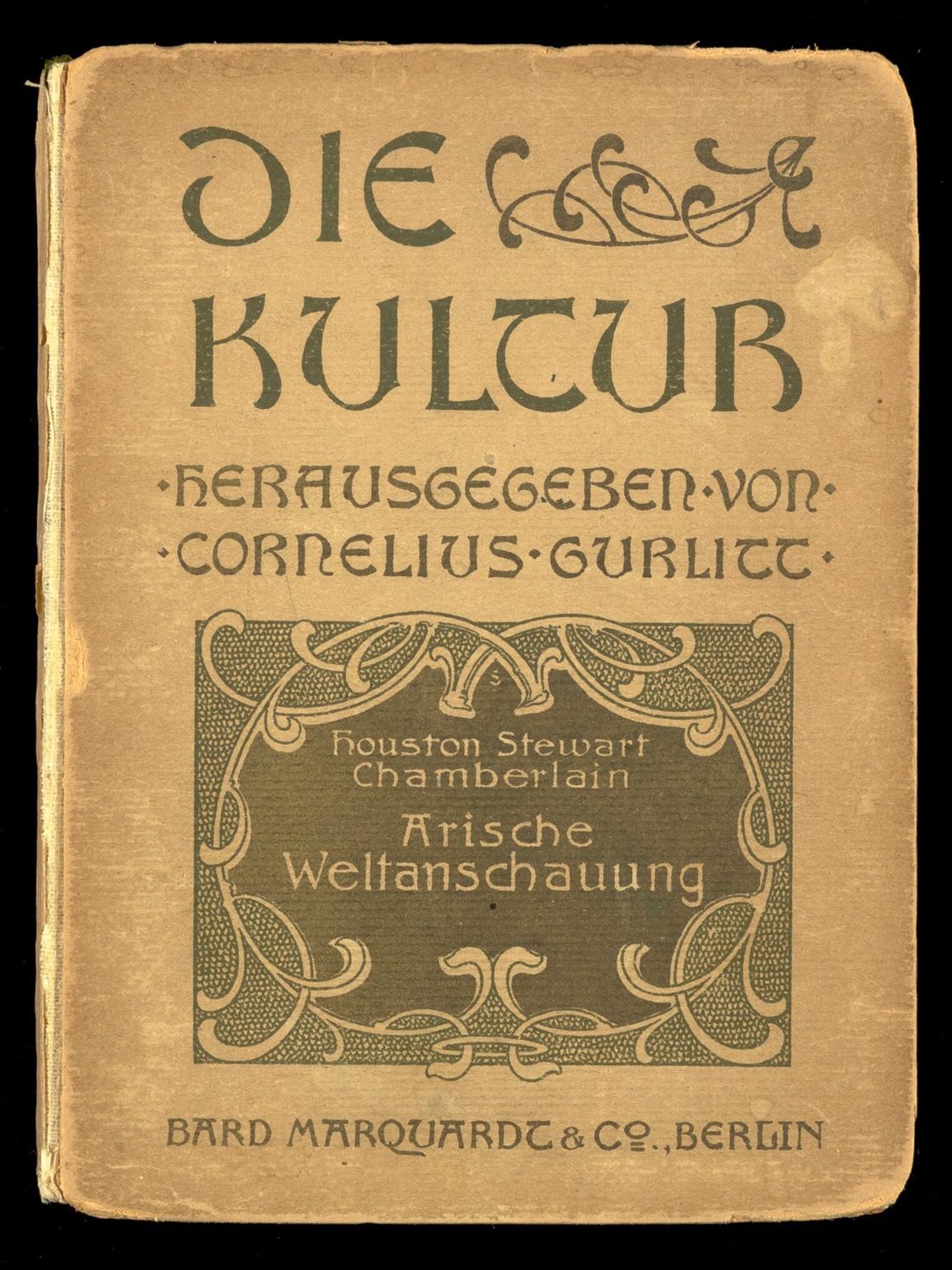
Houston Stewart Chamberlain, Arische Weltanschauung (Aryan Worldview), Berlin 1905, Wiener Holocaust Library Collections
Stewart Chamberlain sought to populise the notion that there existed a Germanic ‘Aryan’ race who possessed superior ‘racial’ characteristics, and that Jews constitute a genetically inferior race who represented a threat to Aryans. Racial antisemitism formed a part of the development of pseudo-scientific racist ideas and eugenicist ideas.
FIGHTING FOR FRANCE: THE DREYFUS AFFAIR
In September 1894, a French intelligence officer working at the German Embassy in Paris as a housekeeper found a torn up note in a bin offering French military secrets to Germany. She passed the unsigned document to the French Military Intelligence Service.
Investigators quickly alighted on the only Jewish member of the General Staff of the French Army as the likely culprit: Alfred Dreyfus (1859–1935). Despite the non-existence of evidence against him, Dreyfus was convicted of treason and sentenced to life imprisonment in December 1894.
Dreyfus’ conviction divided France and became a symbol and rallying point for antisemites and the opponents of liberalism and republicanism in France on the one side, and defenders of the French Republic on the other.
Antisemitism stoked by the case resulted in riots in more than twenty French cities. A number of Jews in the French colony of Algeria were murdered in antisemitic attacks.
“That Dreyfus is capable of treason I deduce from his race”
Maurice Barrès
“it is because he is Jewish that he has been judged, it is because he is Jewish that he has been convicted”
Bernard Lezare, 1897
“These days the Dreyfus affair is the most important and conspicuous fact in contemporary international politics”
Italian newspaper, Avanti, 22 August 1899
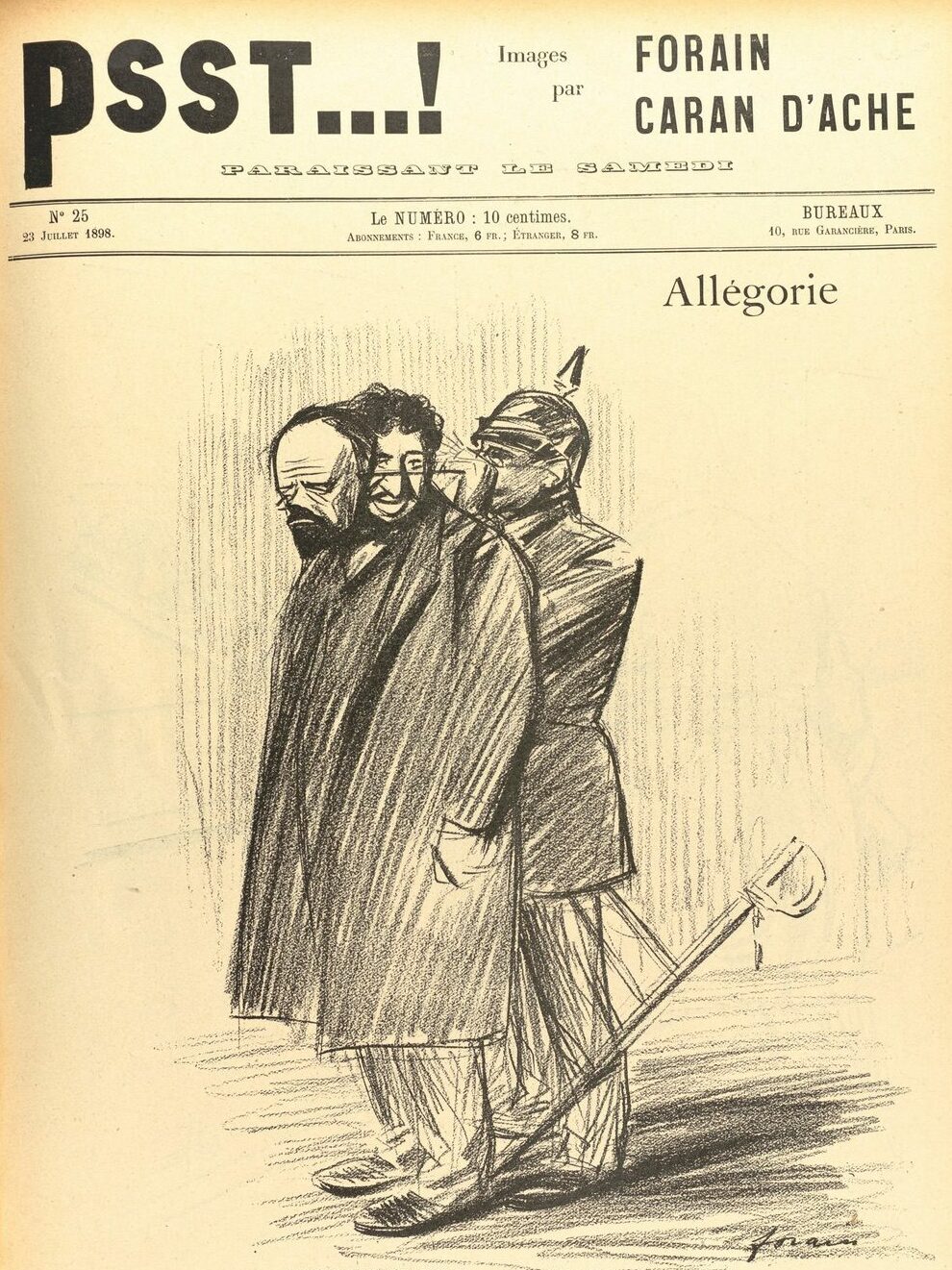
An antisemitic cartoon about the Dreyfus Affair, Psst…!, Wiener Holocaust Library Collections
The cartoon on the front of this antisemitic French journal purports to be an allegory for the Dreyfus Affair.
It shows writer Emile Zola, known for his defence of Dreyfus, as a mask for a figure who is depicted with stereotypically Jewish features. Both are in turn controlled by a Prussian military figure. Much of the French press indulged in violent antisemitic imagery and rhetoric during the Dreyfus Affair.

V. Lenepveu (pseudonym), Paris, 1900, Wiener Holocaust Library Collections
This poster attacked Arthur Ranc, left-wing politician, writer and newspaper editor, for his support for Dreyfus.
Supporters of Dreyfus faced vilification and antisemitic attacks. This poster is from a collection called ‘Musée des Horreurs‘ (Museum of Horrors). The posters featured caricatures of various individuals involved in the Dreyfus Affair.
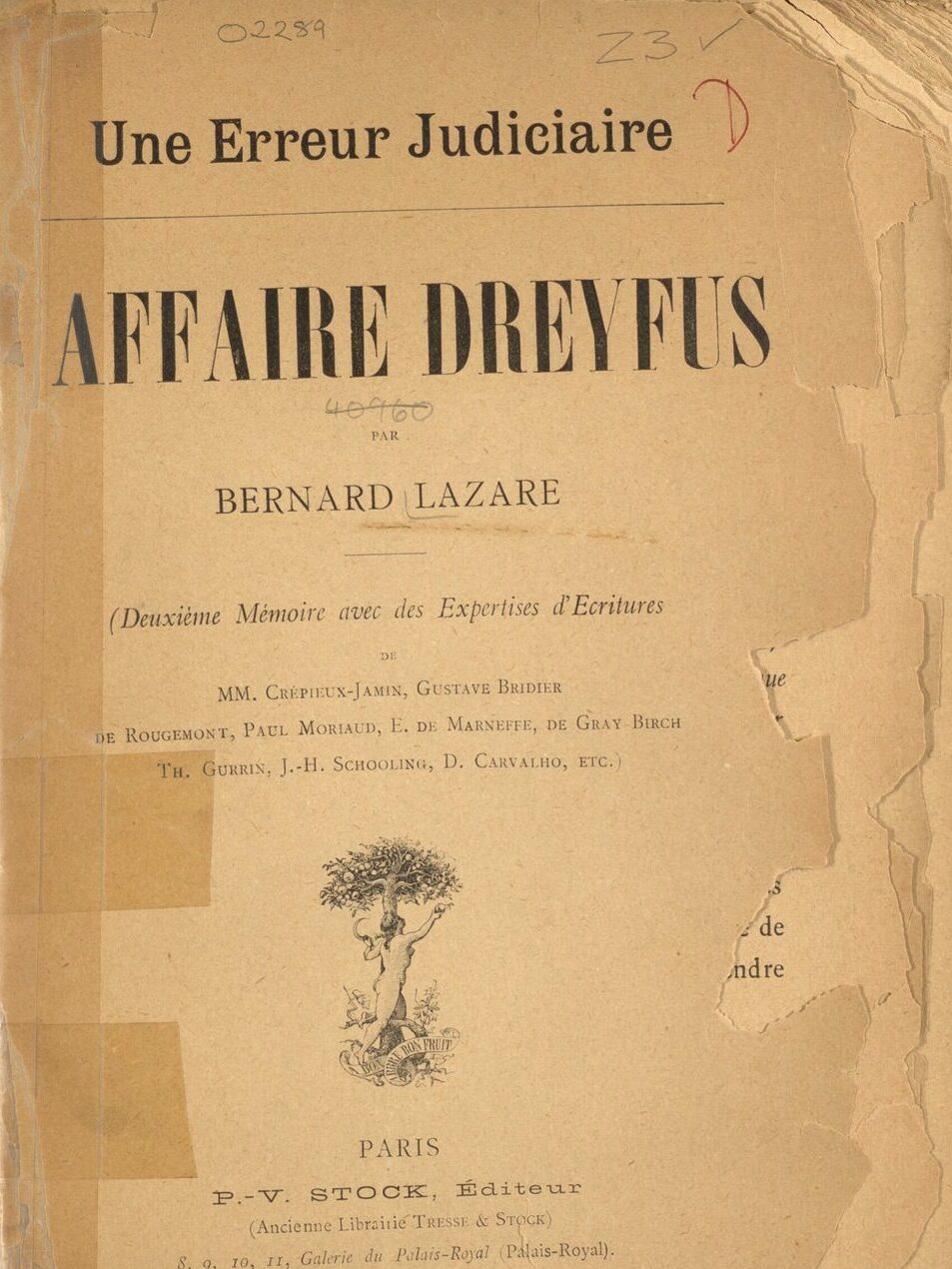
Bernard Lazare, Affaire Dreyfus: Une Erreur Judiciaire (The Dreyfus Affair; a Judicial Error), Paris, 1897, Wiener Holocaust Library Collections
‘Dreyfusards’, – those who supported Dreyfus’ innocence – his family as well as various writers, newspapers, intellectuals and politicians – mounted a determined defence of Dreyfus and of French Republican values.
Dreyfus’ brother Mathieu worked with journalist and writer Bernard Lazare to campaign against the miscarriage of justice.

Le Petit Parisien reported the possibility that Major Charles Esterhazy was the spy in French Army command, 12 December 1897, courtesy of Musée d’art et d’histoire du Judaïsme, Paris.
A military investigation led by Colonel George Picquart found evidence that Esterhazy had committed the espionage of which Dreyfus was accused. The army tried to supress Picquart’s investigations and forged documents to implicate Dreyfus. In 1898, under pressure, the army held a trial of Esterhazy, but proceedings were closed and he was acquitted.
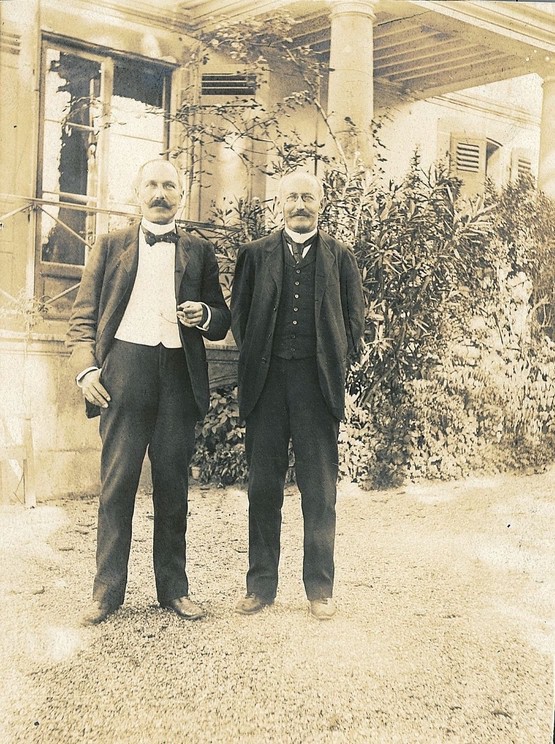
Mathieu and Alfred Dreyfus after Alfred’s pardon and release from prison, c.1900s, private collection
In 1899, Dreyfus was reconvicted on the basis of false evidence. Shortly afterwards he received a presidential pardon but only on the condition that he accept his guilt.
Alfred Dreyfus’ sentence was finally annulled in 1906. He was subsequently reinstated into the French Army and served his country during the First World War.
“Barely six months ago, we would not have found a hundred people in France who would have dared to raise their voices in favour of Captain Dreyfus. Today, there are hundreds of thousands of supporters of the revision of the 1894 trial and, despite all odds, their number is increasing rapidly.”
From the introduction to Bernard Lezare’s
History of a Judicial Error
Fighting Fascists in interwar Germany
In the immediate aftermath of the First World War, Dr Alfred Wiener, a Jewish German academic and war veteran working in Berlin for the Central Association of German Citizens of Jewish Faith – the CV, became concerned about the escalation of antisemitic rhetoric in Germany.
Antisemitism had been a feature of German life since the medieval era, and it had gained new life in German nationalist circles with the development of racial antisemitism in the later nineteen century.
Now, as Germany faced defeat in the war and economic and political difficulties, right-wing and militaristic groups encouraged the development of conspiracy theories that blamed Jews and Communists for Germany’s problems. They propagated antisemitic myths alleging that Jews had shirked their duty or had even caused the defeat of Germany.
Reading the Centralverein newspaper, C.V. Zeitung, Germany, c.1930s, courtesy, Research Network for the Centralverein Collection
CV-Zeitung aimed to counteract the increasingly visible claims that the Jews were a race apart, responsible for German misfortune. The paper reached a circulation of 73,000 in 1926.
“this talk of ‘Jewish supremacy’ is a lie designed, by means of constant and loud repetition, to dupe people who cannot think for themselves”
“there is concern that republican Germany is to earn a Polish-style reputation for Pogroms for itself”
Alfred Wiener, Vor Pogromen, 1919
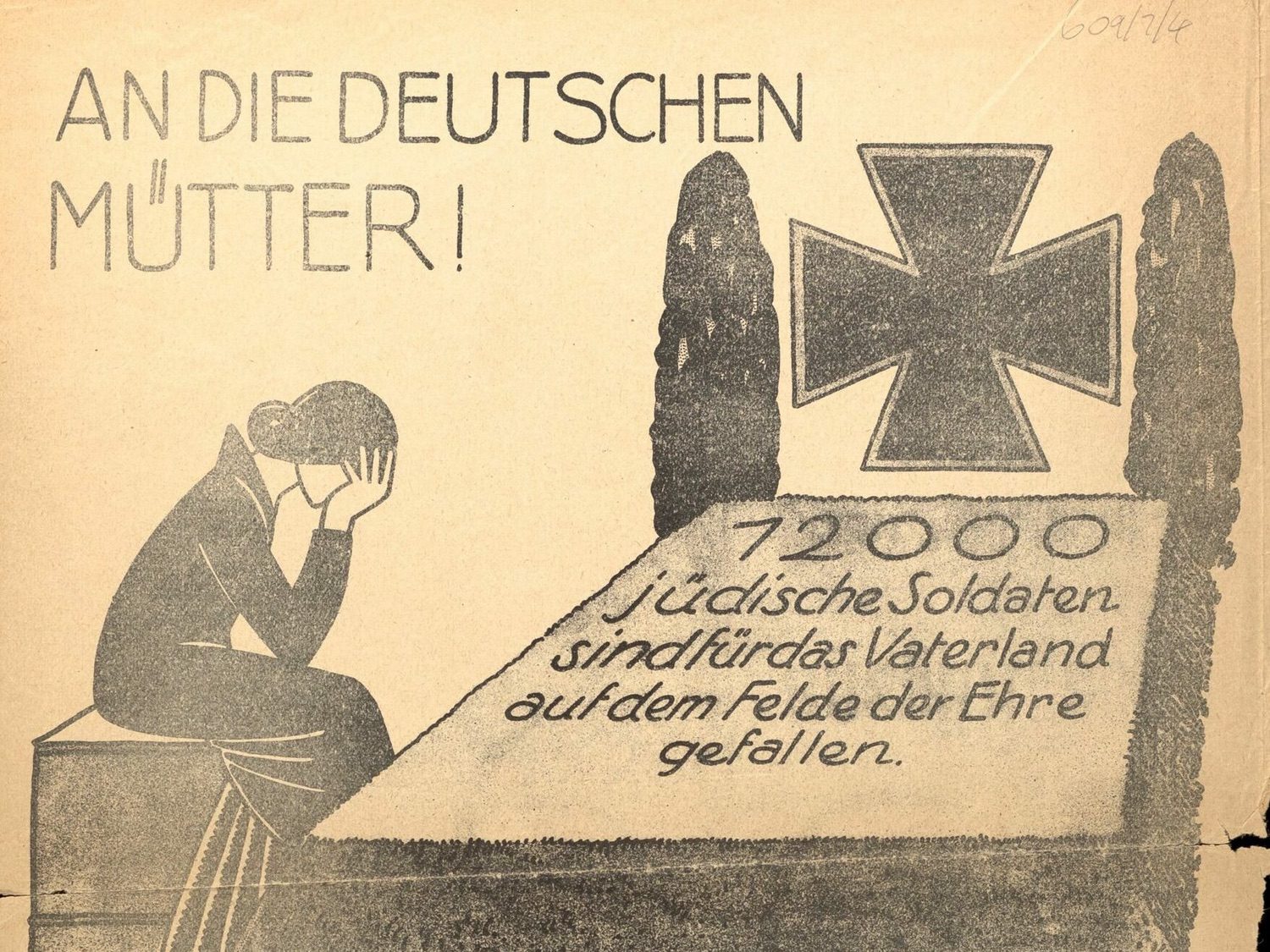
A Reichsbund jüdischer Frontsoldaten (Association of Jewish Soldiers) poster, 1920, Wiener Holocaust Library Collections
This organisation was founded in 1919 to counter accusations that Jews were unpatriotic or had not contributed to the war effort. The top section of the text reads: ‘To the German Mother! 12,000 Jewish soldiers fell for the Fatherland in the field of honour: Christian and Jewish heroes fought together and rest together in foreign soil’
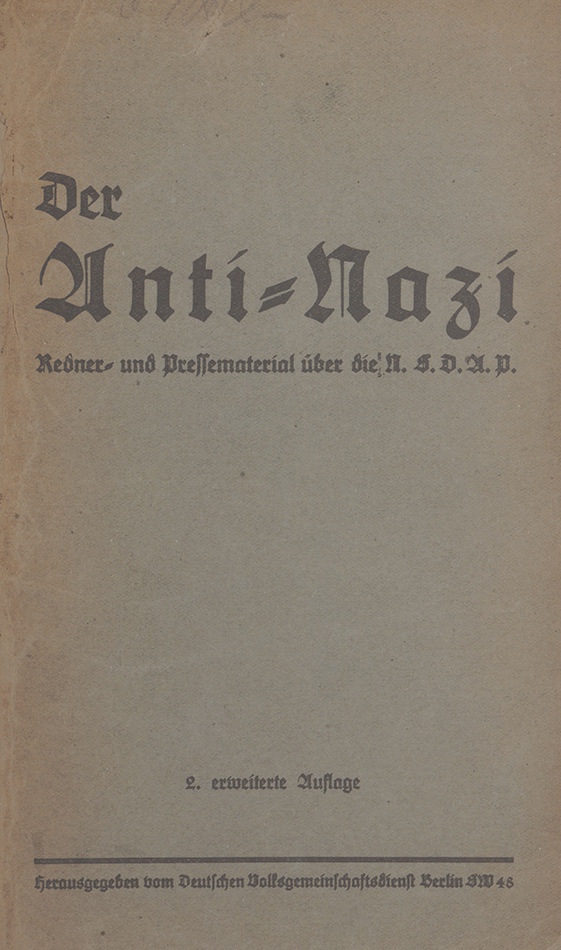

Wiener Holocaust Library Collections
Büro Wilhelmstrasse, Der Anti-Nazi: Redner und Pressematerial über die N.S.D.A.P (The Anti-Nazi: Speeches and Press Material about the N.S.D.A.P), Berlin, 1932 (first edition of was 1930), and Anti-Anti: Tatsachen zur Judenfrage (Facts About the Jewish Question), Berlin, 1932, Wiener Holocaust Library Collections
Büro Wilhelmstrasse, Anti – Anti: Tatsachen zur Judenfrage (Facts about the Jewish Question), Berlin
By the mid-1920s, Alfred Wiener and others in the CV identified The Nazi Party as a particular threat to Germany’s Jews because of the centrality of racist and conspiratorial antisemitic ideas to Nazi ideology.
In 1928, Hans Reichmann of the CV established a small semi-clandestine office, Büro Wilhelmstrasse, to monitor antisemitism in Germany, target propaganda at antisemitic political parties and politicians, and disseminate anti-Nazi information and reports.
The Büro helped distribute Anti- Anti, a collection of leaflets containing facts and arguments to help those who sought to refute Nazi claims and antisemitic propaganda in speeches or in the press.
The Büro’s propagandist and archivist Walter Gyssling later wrote Der Anti-Nazi, which focussed on providing information about and critiquing Nazi politicians and policies.
Between 1929 and 1933, Gyssling also spoke out at public political assemblies in condemnation of the Nazis. Alfred Wiener held private meetings with prominent Germans to try to convince them, through the use of reasoned argument and evidence, of the dangers the Nazis posed.
Street brawl between members of the Nazi Sturm Abteilung (Storm Section – SA) and member of the German Communist Party, the KDP, 1932, Alamy
Street and beer-hall brawls between ideological enemies the SA and KDP members were very common in Weimar Germany. Antisemitism was present in the German Communist Party, but some members were Jewish, and many were motivated to fight Nazis partly in order to challenge their antisemitism.
“Die Nazis sind
unser Unglück”
“The Nazis are
our misfortune”
A phrase used in Büro Wilhelmstrasse leaflets and posters, parodying a famous Nazi antisemitic slogan.
Amsterdam
1933-1939
Alfred Wiener left for Amsterdam in 1933, shortly after the Nazi accession to power. There he founded his own organisation, The Jewish Central Information Office (JCIO), which gathered and published evidence and information about the position of the Jewish community in Germany.
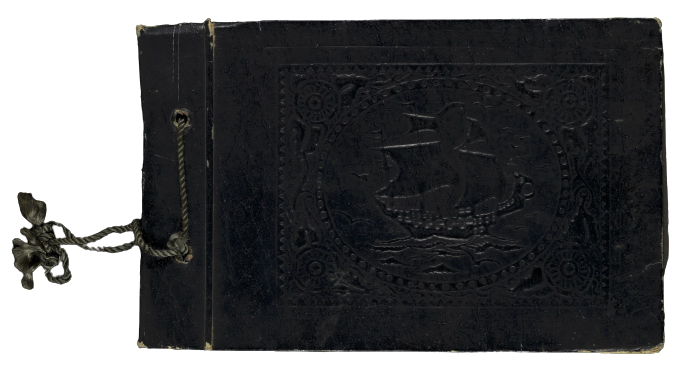
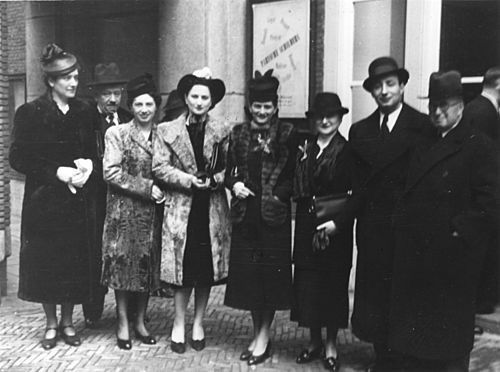
The staff of the Jewish Central Information Office (JCIO) in Amsterdam, c.1930s, including on the far left, Margarethe Wiener and Alfred Wiener, Wiener Holocaust Library Collections
Supported by the Board of Deputies of British Jews, Alfred Wiener was able to employ a small staff at the JCIO, most of whom were Jewish exiles from Germany. The organisation used a network of contacts in Germany to gather material.
Examples of the slogans on these photographs include:
“Jews are not wanted in this place; the inhabitants of this place wish for no interaction with Jews”
In 1935, Fritz Fürstenberg and Käthe Smoszewski travelled across Germany with their dog, from the border with Holland to Berlin. Every time they encountered an antisemitic street sign, they photographed it.
The photographs were passed to the JCIO in Amsterdam, who claimed that they were by a Dutch motorcyclist, in order to protect the couple’s identity.
Multiple copies of this album were made by the JCIO, and the photographs were also shown in slide shows at talks at the organisation’s offices.
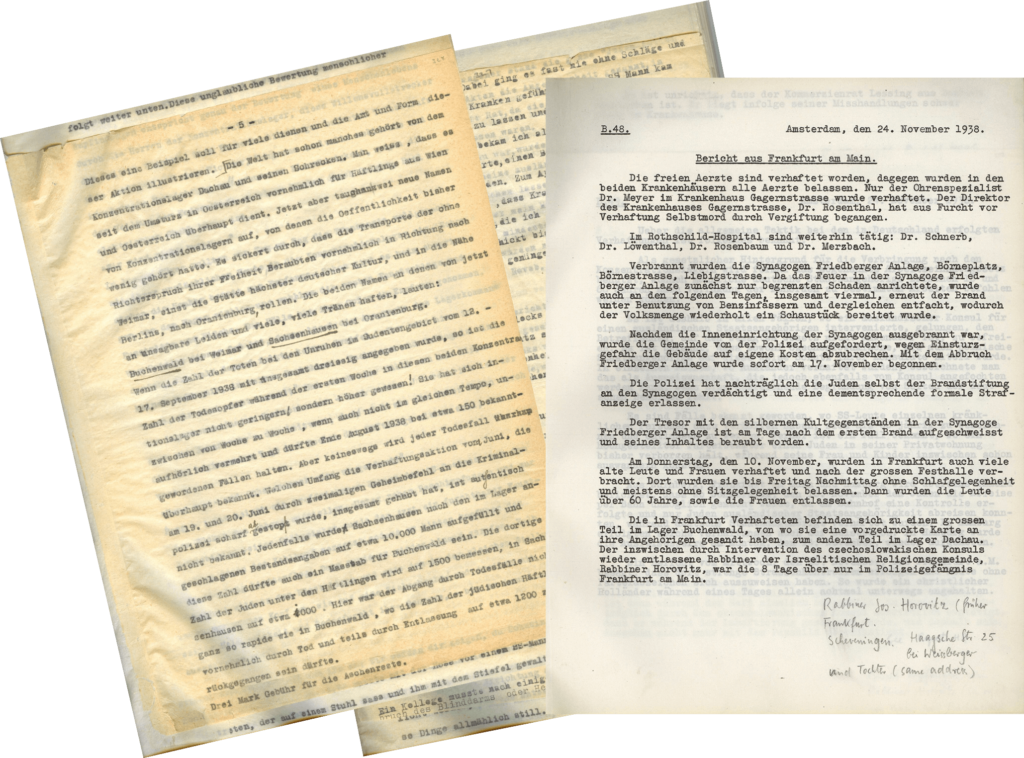
Eyewitness accounts collected by the JCIO in the immediate aftermath of the Nazi-orchestrated attack on the Jewish communities of Germany and Austria during Kristallnacht, 9-10 November 1938, Wiener Holocaust Library Collections
During Kristallnacht, more than 200 synagogues were destroyed, Jewish homes and businesses were attacked and thousands of Jews were assaulted on the streets. Around 30,000 Jewish men were arrested and imprisoned in concentration camps, and hundreds of people were murdered. Many Jewish women were sexually assaulted.
Alfred Wiener and the JCIO immediately began gathering first-hand testimonies to build up a body of evidence about this crime. The JCIO published this material, and this added to the growing awareness internationally of the Nazis’ persecution of Jews.
After Kristallnacht, Alfred Wiener decided he wanted to relocate his organisation. In summer 1939, the JCIO received permission to move to Britain.
Britain
Between
the Wars
There was an increase in antisemitism in Britain after the First World War, and during the 1930s, Jews in Britain faced a rising threat from fascist antisemitism. Fascist groups harassed and sometimes attacked Jews, particularly in London’s East End. Synagogues and Jewish homes and businesses were vandalised.
The Board of Deputies of British Jews set up a committee to work to challenge antisemitism. Meanwhile, Jewish trade unionists established a defence organisation, the Jewish People’s Council Against Fascism and Antisemitism (JPC) and organised street meetings and protests.
At the Battle of Cable Street on 4 October 1936, at least 100,000 people, including Jewish residents, Irish dock workers, Communists and Labour Party members prevented a march by Oswald Mosley’s British Union of Fascists (BUF) from passing through the East End.
“International Jewish finance… that nameless, homeless, all-powerful force which stretches its greedy fingers from the shelter of England to throttle the trade and menace the peace of the west… grasping the puppets of Westminster, dominating every party of the state”
Sir Oswald Mosley, in a speech at the
Royal Albert Hall, 24 March 1935
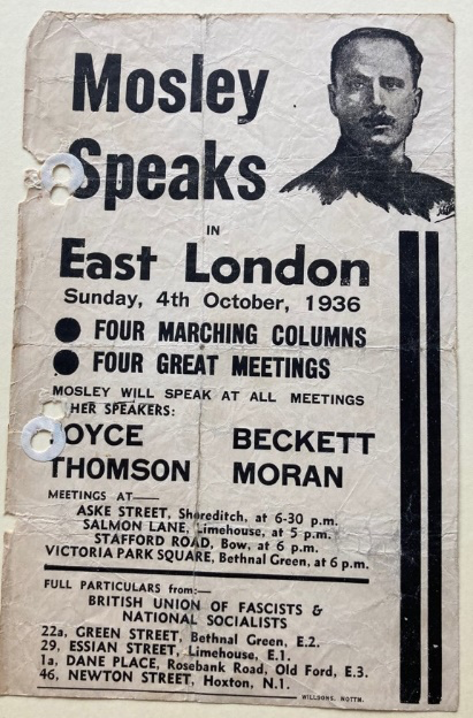
Poster advertising British Union of Fascist meetings and marches in the East End of London on 4 October 1936, courtesy of the People’s History Museum, Manchester.
In the mid-1930s, the British Union of Fascists became more overtly antisemitic. The organisation sought to target the large working class Jewish communities in the East End and to build support amongst ‘white’ working class communities.
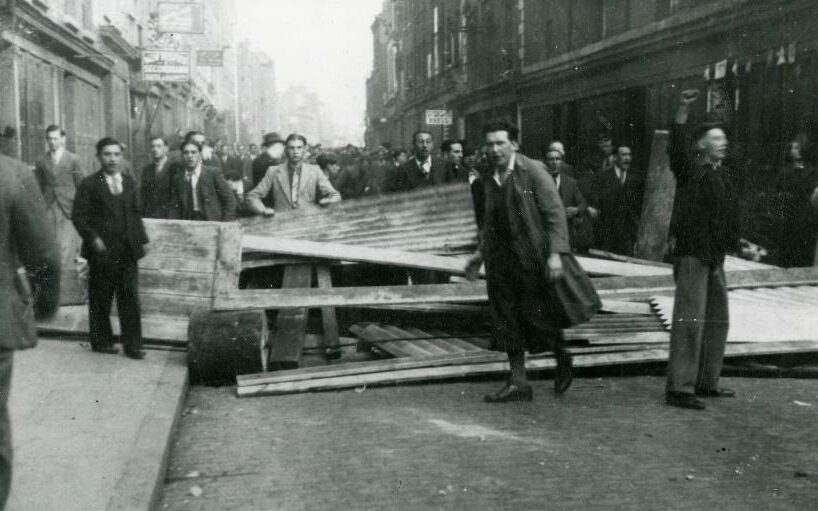
A barricade set up in the East End during The Battle of Cable Street, 1936.
Courtesy of Bishopsgate Institute.
“It was a marvellous day. There was such a feeling of achievement, of working class unity… I was so elated, running all over the place – the sheer excitement of it.”
Mike Mindel, a young Jewish trade union leader, who helped organise the resistance at Cable Street
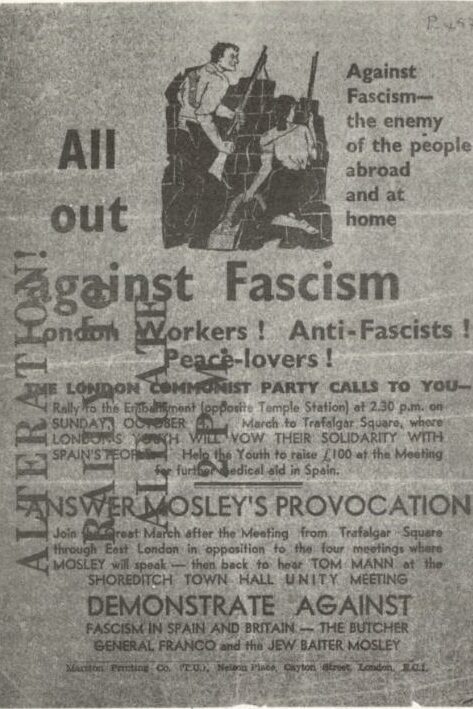
A hastily printed British communist party flyer calling for “London Workers! Anti-Fascists! and Peace-Lovers!” to rally at Embankment and then Shoreditch to challenge the BUF’s planned march to the East End on 4 October 1936, image from Joe Jacobs’ memoir Out of the Ghetto London: Simon, 1978.
Despite widespread opposition to the fascist march taking place, the Home Secretary allowed it to go ahead. Counter-rallies were hastily organised.
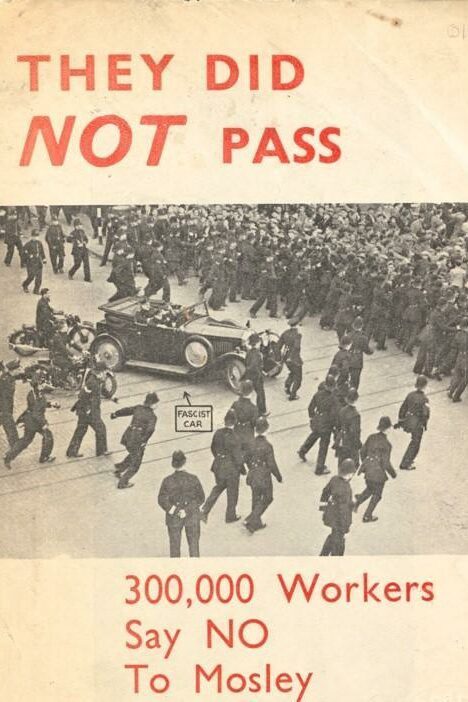
Pamphlet published by the Independent Labour Party in the aftermath of the Battle of Cable Street as ‘A Souvenir of the East London Workers’ Victory over Fascism’, 1936, Wiener Holocaust Library Collections
‘They Shall Not Pass’
‘They Did Not Pass’
Slogan scrawled all over the East End after the Battle of Cable Street
A photograph during the battle of Cable Street showing police attempts to beat the protestors back, 1936, courtesy of Bishopsgate Institute
At Cable Street, around 7,000 of police officers were deployed to try to allow the fascist marchers to process through the East End. Many antifascist demonstrators were arrested. Ultimately, in the face of the huge demonstration, Mosley called the march off and the Blackshirts were escorted back to central London by police.
In the week following Cable Street, residents of an almost entirely Jewish estate in East London were intimidated and attacked by BUF Blackshirts. On Mile End Road, Jewish shops were attacked. After Cable Street, membership of the British Union of Fascists rose.
The Jewish Defence Committee
Documents from the Jewish Defence Committee Archives of the Board of Deputies of British Jews, JDC Archives, Wiener Holocaust Library Collections
The Jewish Defence Committee was established in 1936. In an appeal for funds they stated that they sought “to ensure that through the spoken and written word, and by every appropriate and legitimate means, the calumnies and false allegations against Jews, so sedulously and unscrupulously spread by anti-Jewish organisations and groups, shall be countered by the widest possible dissemination of the facts.”
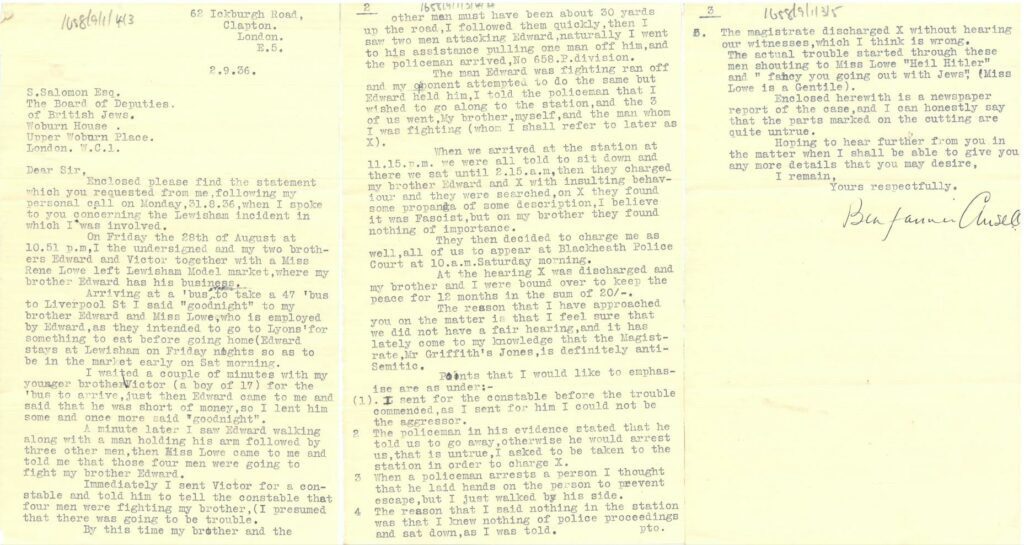
A letter sent to Sidney Salomon at the Board of Deputies of British Jews detailing an antisemitic incident and its treatment by the police and magistrates, JDC Archives, Wiener Holocaust Library Collections

Lists of speakers organised by the Defence Committee of the Board of Deputies of British Jews, May 1933, JDC Archives, Wiener Holocaust Library Collections
The Defence Committee organised speakers to attend public meetings across the country to counter antisemitism in Britain and speak out against the persecution of Jews in Nazi Germany.
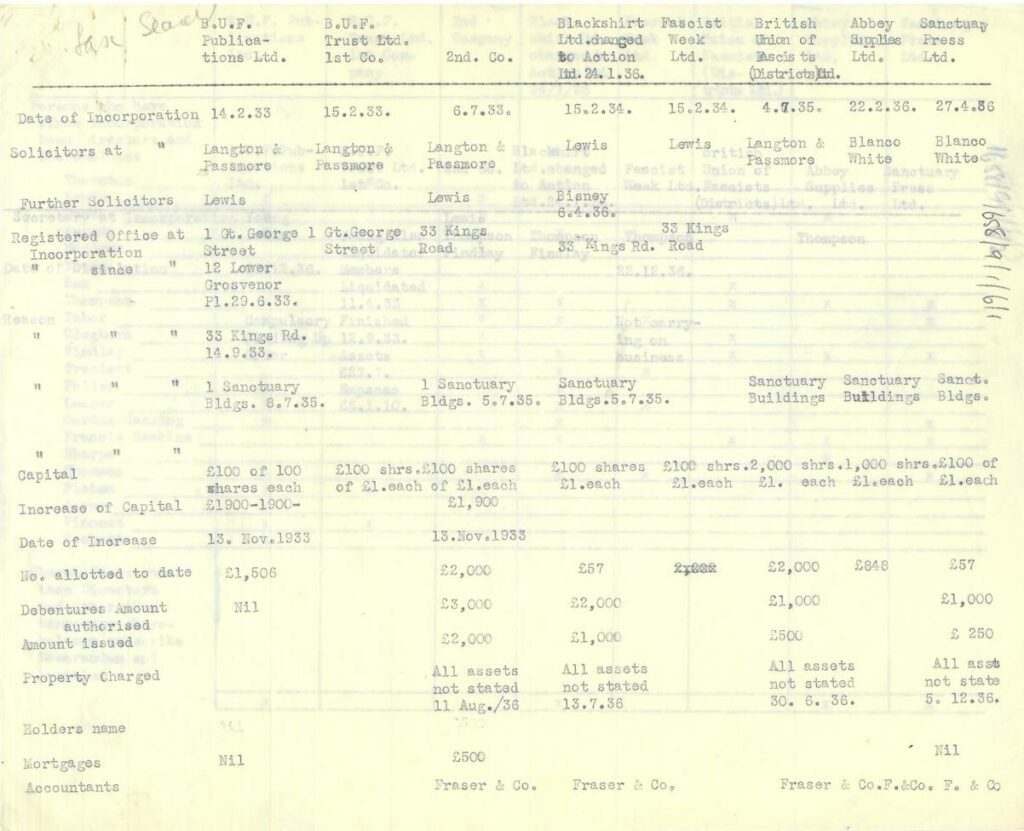
A document compiled by the Defence Committee of the Board of Deputies summarising research they had conducted into the sources of income of the British Union of Fascists, JDC Archives, Wiener Holocaust Library Collections
The Red Book of the Right Club, c. 1939, Wiener Holocaust Library Collections.
A ledger detailing the names of members and supporters of the Right Club, a pro-Nazi British group.
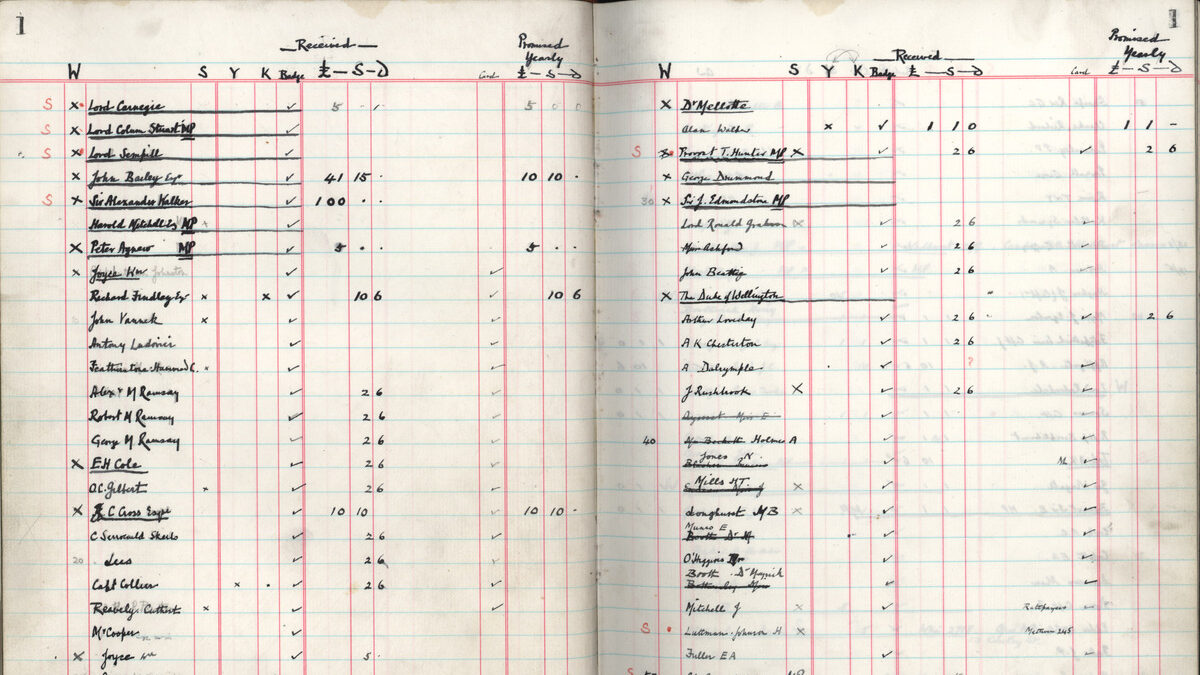
The Second World War and the Holocaust
During the war and the Holocaust, Jews and others fought against the murderous antisemitism of the Nazis and their collaborators. To find out more, visit The Wiener Holocaust Library’s online exhibition, Jewish Resistance to the Holocaust.
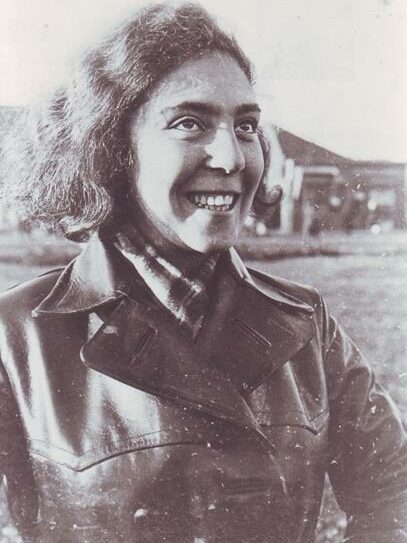
Tosia Altman, date unknown, courtesy of the Moreshet Archive
Altman, a member of socialist Zionist youth group Hashomer Hatzair, was a courier and weapons smuggler in German-occupied Poland. She died of injuries sustained on the run after the Warsaw Ghetto Uprising on 26 May 1943.
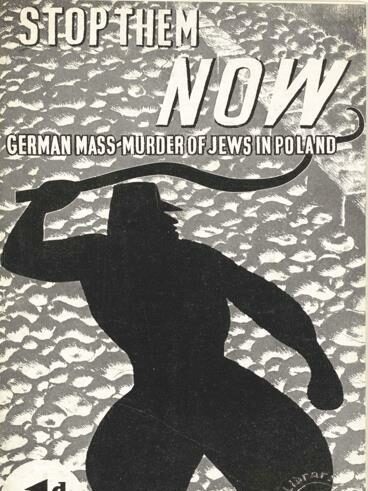
Szmul Zygielbojm, Stop Them Now, September 1943, Wiener Holocaust Library Collections
The author of this pamphlet was a Polish-Jewish politician and refugee living in London. In it, he documented reports of Nazi atrocities. In November 1943, on learning that his wife and son had been killed following the Warsaw Ghetto Uprising, Zygielbojm killed himself.
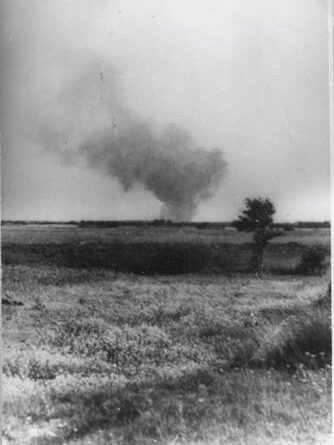
Smoke coming from burning buildings in Treblinka death camp during the prisoner uprising of 2 August 1943, courtesy of Yad Vashem Photo Archive, Jerusalem
The photograph, taken by a member of the Polish Underground, records the attack on the camp by 700 prisoners. Several hundred prisoners managed to escape. Seventy survived the war.
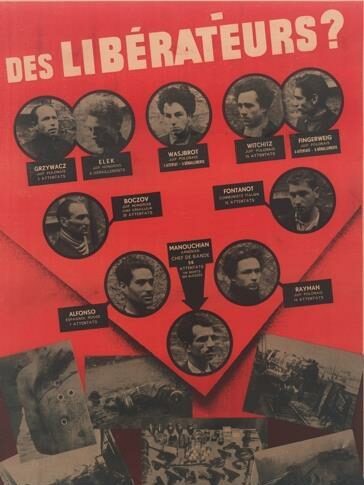
A poster, known as ‘Affiche Rouge’; the ‘Red Poster’; distributed by the German authorities, 1944, © Musée de l’Armée/RMN-GP
This poster was displayed widely throughout France following the execution of a Jewish Communist armed resistance group in France. In some places, the slogan “they died for France” was scrawled on the poster.

Jewish Lithuanian partisan group ‘The Avengers’ on their return to Vilna at the time of the liberation of the city by the Red Army, July 1944
Wiener Holocaust Library Collections
Post-War Britain
In post-war Britain, fascist groups proliferated. In 1948, Oswald Mosley unified 51 of these organisations in his Union Movement. Bethnal Green and Dalston in the East End of London once again became sites where fascists and antifascists held rival public meetings and disrupted each other’s gatherings.
The Association of Jewish Ex-Servicemen and Women, AJEX, responded to the fascist threat with a programme of public meetings. The Defence Committee of the Board of Deputies monitored fascist organisations and continued their public education efforts. The 43 Group, founded in 1946 by mainly Jewish ex-servicemen and women, sabotaged and broke up fascist meetings, attacked fascists and sent agents to infiltrate fascist organisations.
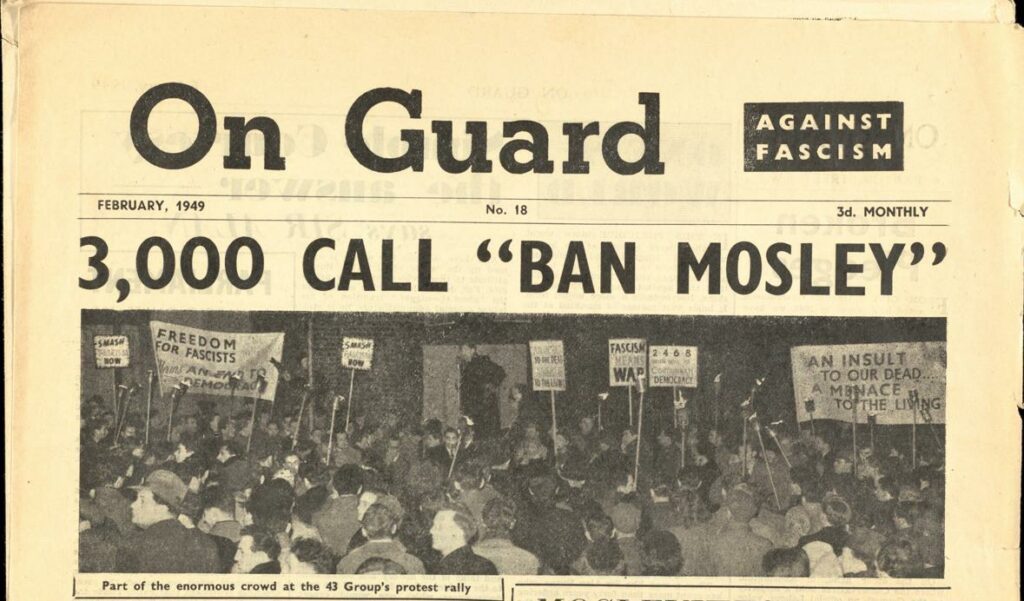
Front page of On Guard, the newspaper of anti-fascist organisation the 43 group, February 1949, courtesy the family of Mildred Levy
“Anti-Semitism in this country… became serious after steady infiltration for six years of Nazi and Fascist propaganda… the six years of war have not made people less susceptible.”
Sidney Salomon, Executive Officer of the Jewish Defence Committee of the Board of Deputies of British Jews, 1946

An antifacist protest in East London, c. late 1940s,
from an AJEX collection, courtesy of the Community Security Trust
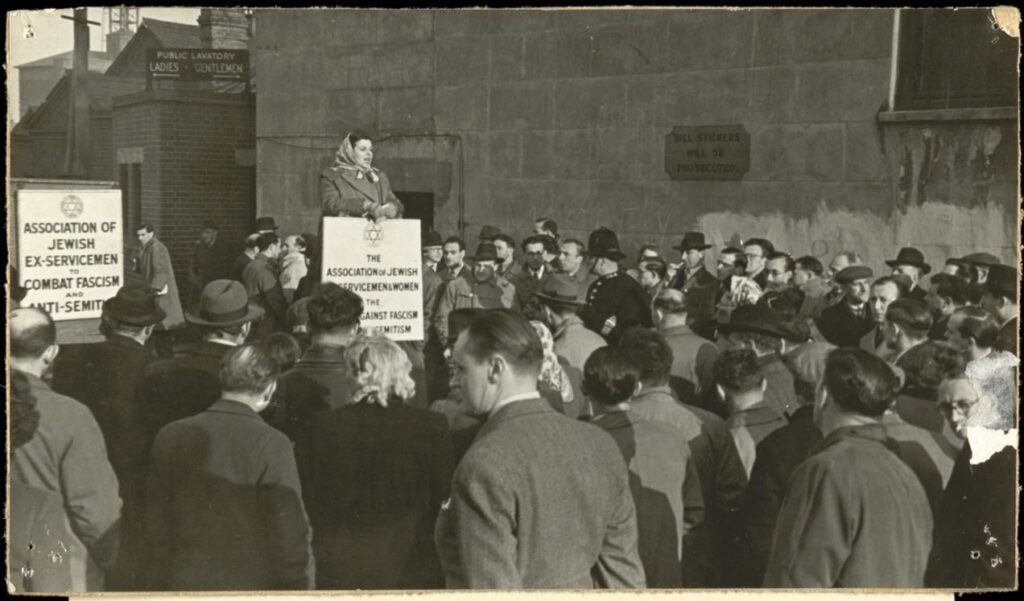
“One Sunday we set up a record. We turned over thirteen meetings all in the space of about three hours… we just moved into a thing, turned over a platform, gave a few Blackshirts a beating and kicked them up the arse.”
43 Group Member Alexander Hartog
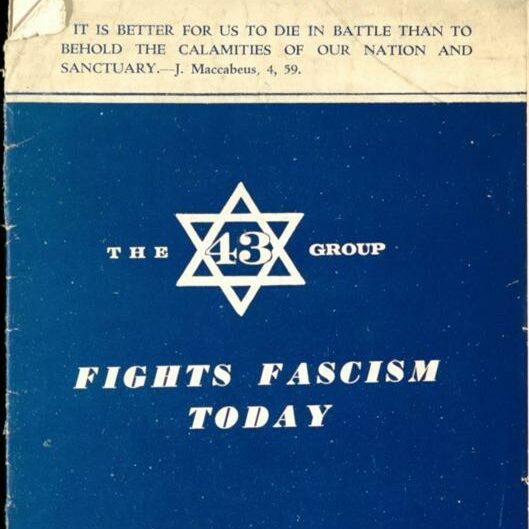
A 43 Group pamphlet, c.1947, cover and inside page, courtesy of the family of Mildred Levy
“I just felt when it was all happening that I had to fight… I was a Jewish girl and I had to fight the fascists.”
43 Group member Mildred Levy
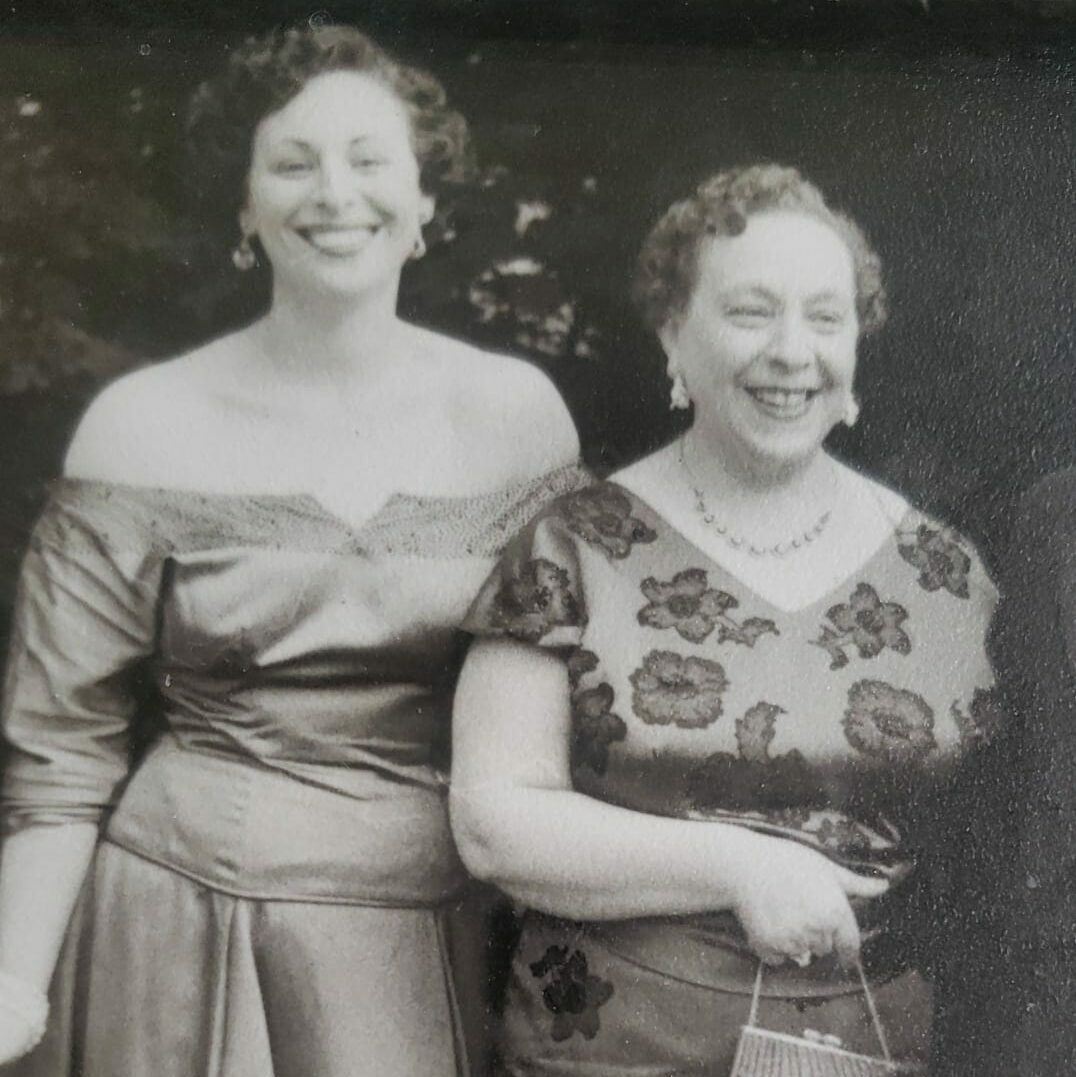
Mildred Levy, date unknown,
courtesy of the family of Mildred Levy
Fascists at a Mosley rally in Dalston, May 1948,
from an AJEX collection, courtesy of the Community Security Trust
The Continuing Struggle
The Board of Deputies of British Jews were sometimes criticised for not taking a more active stance against fascists and antisemites in the 1930s and 1940s. However, documents in the closed archive of the Board’s Jewish Defence Committee (JDC), deposited at The Wiener Holocaust Library in 2011, show that the JDC were much more actively involved in fighting antisemitism than they revealed at the time.
The JDC conducted extensive operations to monitor fascist and antisemitic groups, and document and report antisemitic incidents, as well as record cases of police inaction in the face of overt antisemitism, for example during public speeches or meetings.

Documents recording ‘Examples of insulting, abusive and provocative statements made by Fascist Speakers at Street Corner Meetings in 1950’, compiled by the Defence
committee of the Board of Deputies of British Jews, Wiener Holocaust Library Collections

Meeting Report, 18 September 1949, JDC Archive,Wiener Holocaust Library Collections
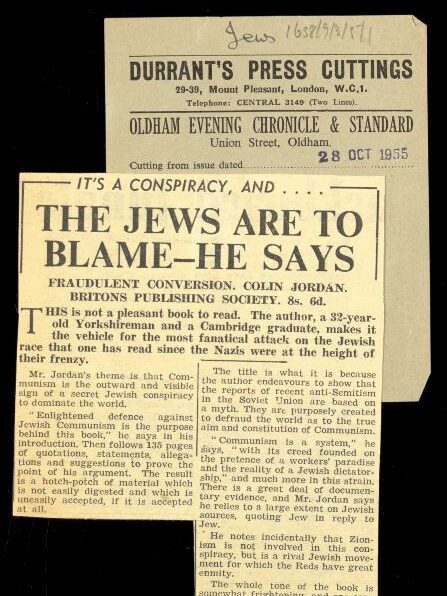
Newspaper clippings collected by the JDC about Colin Jordan, who in 1962 founded the National Socialist Movement of Britain, early 1940s, JDC Archives, Wiener Holocaust Library Collections


Article in the Wiener Library Bulletin documenting Colin Jordan’s activities, 2 July 1964, Wiener Library Collections
In the post-war period, The Wiener Library, as the JCIO had become known, based in London since 1939, continued to document antisemitism, both historic and present. The Library’s Bulletin published many articles highlighting and analysing the activities of fascists and antisemites, particularly those active in Britain and Germany.


Members of the Women’s Campaign for Soviet Jewry, ‘the 35s’, calling for the release of 35 year old Raiza Palatnik and others Jews held in arbitrary detention in the Soviet Union, 1971, © Sidney Harris, The 35s’ Collection, Central Archives for the History of the Jewish People

Members of the 62 Group were amongst those who attacked members of the Union Movement during a march through Manchester, 29 July, 1962, AP/Shutterstock
The militant 62 Group was founded to take direct action against fascists, and particularly Colin Jordan’s National Socialist Movement. At a rally in Trafalgar Square in 1962, Jordan spoke under a banner reading “Free Britain From Jewish Control”. A riot ensued after members of the 62 Group, the Communist Party of Great Britain and the Campaign for Nuclear Disarmament attacked NSM supporters.
The 62 Group disbanded in 1975. Former members went on to found the Community Security Trust and Searchlight antifascist magazine, which has since become the organisation HOPE not hate.
A protest in London against the treatment of Jews in Poland, 1968, Courtesy of the Community Security Trust
This protest was staged in response to a government orchestrated campaign of harassment and persecution of Jews in Poland.
New
Challenges:
Despite the vast quantity of historical evidence documenting the events of the Holocaust, some of which is held in The Wiener Holocaust Library, from the 1960s, forms of antisemitism developed that denied, distorted or minimised the key events of the Holocaust. The Library promotes knowledge and understanding of the Holocaust to challenge Holocaust denial as a form of antisemitism.
Criticisms of the policies of the State of Israel, or of the idea of Zionism – the idea that the Jewish people should have a national homeland – are sometimes antisemitic. This form of antisemitism is modern, but it often draws upon older antisemitic ideas.
Examples of antisemitic anti-Zionism include the notion that Israel has enormous global power and the linking of Israel to implausible conspiracy theories. Some discourse about Israel contains echoes of the slanders contained in the Protocols of the Elders of Zion. Failing to distinguish between ‘Jews’ and Israel is also common and implies the antisemitic idea that Jews all have dual loyalty to Israel and other countries. In recent decades, Islamists have often embraced these forms of antisemitism.

The front cover of the New Statesman, 14 January 2002
This cover image related to an article investigating the influence of what was termed the “pro-Israeli lobby” on British politics. The gold outsized Star of David seems here to be used as if it is a sinister symbol and to imply that there are wealthy Jews who are somehow more powerful than the British state. The use of the term “a kosher conspiracy?” suggests the antisemitic idea that Jews work in concert secretly to try to gain power and influence.
“You won’t find the Holocaust mentioned in one line, not even in a footnote, why should [you]. If something didn’t happen, then you don’t even dignify it with a footnote.”
David Irving, speaking about his revisions to his book Hitler’s War

Roger Garaudy, The Founding Myths of Modern Israel, 2000, originally published in French in 1996, Wiener Holocaust Library Collections
French writer Roger Garaudy was convicted in France of Holocaust denial in 1998 in relation to this book. Since 1990, it has been illegal in France to question the existence of crimes against humanity.
Protests against the work of antisemite and Holocaust denier David Irving, likely in relation to his employment by the Sunday Times, c.1992, courtesy of Community Security Trust.
David Irving is a British historical writer who since the 1970s has sought to minimise the scale of the Holocaust, and has denied that Hitler was antisemitic or had a key role in the perpetration of the Holocaust.
Despite Irving’s record as a racist antisemite and a falsifier of history, the Sunday Times employed Irving to assess Josef Goebbel’s diaries, part of which were discovered in 1992.
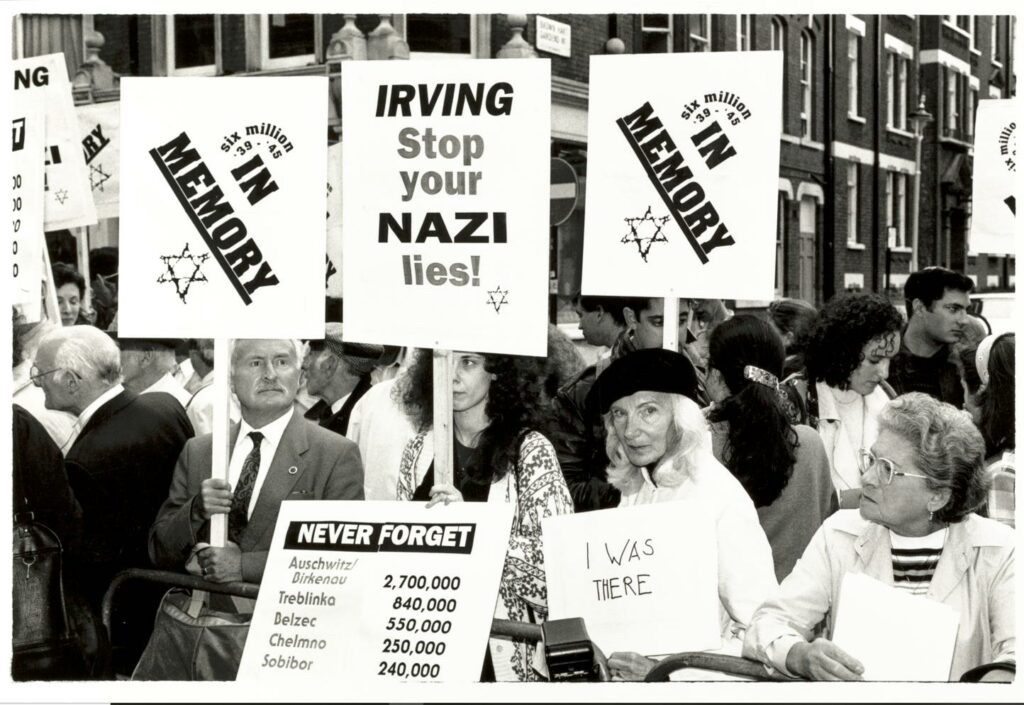

Deborah Lipstadt and her lawyer, Anthony Julius, after their victory against David Irving, February 2000, image from Deborah E. Lipstadt, History on Trial: My Day in Court with David Irving, 2005
David Irving Vs Penguin Books Ltd and Deborah Lipstadt
In 1996, David Irving sued American historian Deborah Lipstadt and her publisher in Britain for libel in relation to Lipstadt’s claim in her book Denying the Holocaust that Irving deliberately distorted evidence about the Holocaust in his work.
At the trial in the high court in 2000, Lipstadt was vindicated. Expert evidence demonstrated that Irving falsified and misrepresented evidence about the Holocaust.
Irving “for his own ideological reasons persistently and deliberately manipulated historical evidence”.
Mr Justice Gray in his verdict at the Lipstadt-Irving trial.

A sign displayed at a Quds Day rally in London held in support of the Palestinian people, 1985, courtesy of the Community Security Trust
This sign equates the actions and policies of Israel, a state with a majority Jewish population, with those of the Nazis. Given the Nazis’ mass murder of six million Jews, the implied comparison between Jews and Nazis is offensive and antisemitic.
Damage inside Wimbledon and District Synagogue following an attack, March 1986, courtesy of the Community Security Trust
The Community Security Trust (CST) monitor and gather evidence about antisemitic attacks and desecrations of synagogues and Jewish graves and cemeteries.
CST was set up partly in response to the growth of an antisemitic terrorist threat that developed from the 1970s onwards.

Graffiti desecrating Jewish Graves in Southampton Cemetery, August 1993,
courtesy of the Community Security Trust
CST’s archives show that there were similar incidents across England in the 1980s and 1990s. The graffiti here includes reference to the National Front and the British National Party, antisemitic far-right political parties formed in Britain in 1967 and 1982 respectively.
Fighting Antisemitism
Today
Antisemitism remains a threat in Britain, France, Germany, and globally. Antisemitic ideas spread rapidly across the internet, and antisemitic harassment and violence on the streets has increased recently too. In the last few years in France, there have been a number of horrific murders committed by perpetrators motivated by antisemitism. Germany too has seen antisemitic and racist murders.

Demonstrators at a silent march protesting antisemitism and the antisemitic murder of 85-year old Mireille Knoll, 28 March 2018, NurPhoto/NurPhoto/Getty images
The far right continue to hold racist ideas about Jews and to promote ideas about ‘the Jews’ leading global conspiracies to gain political and economic power, or to harm children, or to somehow ‘replace’ white communities with migrants. On the far left it is common to find conspiracy theories associating Jews, or ‘Zionists’, with capitalism and imperialist power. Islamist extremists claim that Jews are waging a war against Islam. These all share an underlying belief that Jews are plotting to oppress others.
The struggle against antisemitism necessarily continues. Protests against antisemitism have been seen in Britain and France. Campaigners against antisemitism work to counter antisemitic disinformation. Organisations like the Community Security Trust in Britain monitor antisemitic incidents and use intelligence to track down those responsible and try to ensure that the authorities prosecute antisemitic criminality.

A photograph taken by a rightwing extremist and Holocaust denier who tried to attack a synagogue during a Yom Kippur service in 2019 in Halle, Germany, courtesy the Community Security Trust

People walking past an mural by the artist Mear One in London Tower Hamlets,
London, 2012, Mike Kemp/Corbis News/Getty Images
“Some of the older white Jewish folk in the local community had an issue with me portraying their beloved #Rothschild or #Warburg etc as the demons they are”
Artist Mear One (Kalen Ockerman), in response to criticism of his mural
This mural abounds with antisemitic imagery reminiscent of some of that produced by the Nazi Party: a group of rich bankers are portrayed as stereotypically Jewish. They are seen counting money and oppressing others.
In 2012, local authorities sought to remove the mural. Jeremy Corbyn, then a backbench Labour MP, expressed support on Facebook for the mural remaining in place. This incident became a focus for concern in 2018 at the time that Corbyn was leader of the Labour Party.

Over 3,000 people gather in Parliament Square for #TogetherAgainstAntisemitism, organised by the CAA and addressed by Robert Rinder, Tracy-Ann Oberman, Tom Holland and others, shortly before the General Election, December 2019, courtesy of CAA, © Nathan Lilienfeld
Founded in 2014, CAA campaigns against antisemitism in Britain and elsewhere through public rallies, education work, litigation and other activities. Their rally at the Royal Courts in 2014 saw 5,000 people protest failures of the criminal justice system to tackle antisemitism during period of conflict in Israel. In 2018, the CAA initiated a successful private prosecution of Holocaust denier and antisemite Alison Chabloz. In 2019, the CAA and the Jewish Labour Movement complained to the Equalities and Human Rights Commission (EHRC) about antisemitism in the Labour Party. The resulting EHRC report has seen reforms introduced in the party.
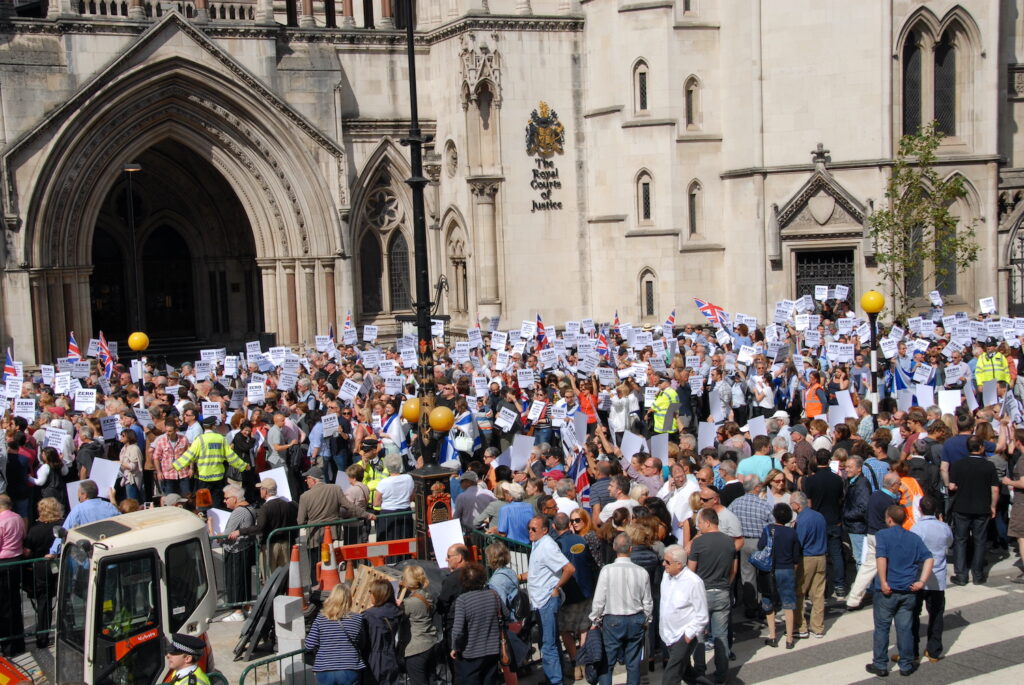
Campaign Against Antisemitism (CAA) rally at the Royal Courts of Justice in London, August 2014, courtesy of CAA, © Nathan Lilienfeld
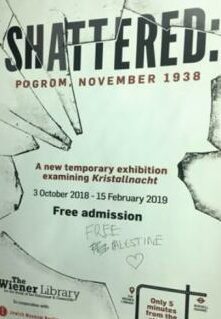
A poster in Russell Square tube station adverting a Wiener Library exhibition on Kristallnacht in Nazi Germany was twice defaced in 2018, Wiener Holocaust Library Collections
Kristallnacht was a massive attack on Jewish people and property that occurred in November 1938.
The graffiti on the posters read “Free Palestine”. This is not in itself an antisemitic slogan, but when added to a poster for an exhibition about Nazi terror against Jews, it is offensive and makes a false equivalence.
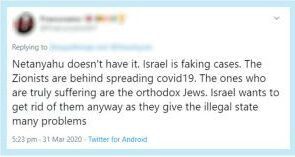
A post on Twitter gathered by the Community Security Trust, 2020

Graffiti on a hoarding in Haringey, London, April 2021, courtesy of The Community Security Trust
This graffiti was collected and published as part of the Community Security Trust’s work in challenging antisemitism.
The Covid-19 pandemic has seen an explosion of antisemitic ideas, particularly spread online. In echoes of the wave of anti-Jewish attacks that occurred at the time of the Black Death in Europe in the fourteenth century, conspiracy theories have blamed Jews for spreading the virus, or creating the virus (calling it a “Jew flu”), or faking the existence of the virus.
Recorded antisemitic incidents in the UK in 2021, the highest ever figure reported to CST in a single year
Incidents were of extreme violence involving potential grievous bodily harm of a
threat to life
(8%) of the incidents were assaults
Incidents were at schools or affected Jewish students or teachers
Incidents of desecration
Incidents featured abusive behaviour
Incidents contained antisemitic rhetoric linked to Covid-19
Source: The Community Security Trust, Antisemitic Incident Report 2021 [end]

The number of antisemitic incidents recorded in Britain by the Community Security Trust, 2007-2021
The most common type of incident involved people using the conflict in Israel and Palestine in 2021 as an opportunity, or excuse, to harass Jewish people: 826 incidents (37% of the total). These included incidents using anti-Israel language alongside antisemitic language; incidents where cars draped in Palestinian flags were driven round Jewish communities while abuse was shouted at residents; shouts of “free Palestine” directed randomly at Jews who could be identified by their clothing.
